

10 Tips for Making a Great Research Video

Scientists! If you are gearing up to make a short video on your research for the JoVE Film Your Research Contest, then here are some tips from the JoVE Team which can help you plan and produce the video.
JoVE is organizing our first ever Film Your Research contest for early career researchers worldwide. We’re inviting scientists to make a two-minute video of their research: showcasing specific experimental methods that they use in their labs or field. The video should also address a big picture application of the specific research in the real world. Four lucky winners will be awarded up to $3,000 in cash awards!
This is an opportunity for scientists to showcase to a global audience “real science” from “real labs and field stations” around the world. Here are some valuable tips for creating an impactful research video.
1. Know your audience
Be sure to avoid acronyms and keep your explanations short. Your video will be widely shared with a wide variety of audiences, including people outside your field. Many of them may not even be from a scientific field.
2. Get permission from professors and department
It is very important to get your Principal Investigator/advisor’s permission before you start making this video. Clarify with them that your video is not a representation of your detailed findings. Rather, the video should highlight your research question, the research method/process, and its significance or potential impact.
3. Watch other videos: do the homework
We highly recommend watching some of the following videos from JoVE that highlight research methods, but also convey a big picture relevance and applications.
February 2017: This Month in JoVE A short compilation of videos from the fields of Biology, Chemistry, Psychology, and Neuroscience.
March 2017: This Month in JoVE A short compilation of videos from the fields of Developmental Biology, Bioengineering, Psychology, and Medicine.
June 2016: This Month in JoVE A short compilation of videos from the fields of Chemistry, Engineering, Developmental Biology, and Environment.
4. Storyboard/Write a script
Writing a brief script (laying out your plans) before you start filming will give you much more clarity and help you make a better video. Use your storyboard or script as the step-by-step plan for delivering your message and getting the best shots of your experiment and research.
5. Choose an audio style
This will be key to delivering your message. Choosing an audio style will lead you towards choosing a storytelling style. Here are some options:
a) Voiceover (first person narration)
b) Interview style communication facing the camera
c) Journalistic/reporter style delivery (following the experiment-in-progress and talking “live” into the camera)
You can also choose to use just text and background music to convey your message instead of one of the above approaches.
6. Video making tools
Choose a video filming tool based on your budget, what’s available, and what’s accessible. Your options may include DSLR camera, GoPro, Flip Ultra HD Video camera, or a modern smartphone. Most smartphones nowadays have a pretty good built-in camera, microphone, and are compatible with video-editing apps. However, consider using a tripod if you need to film an experiment (without shaky hands) from a certain distance or height.
7. Ask your library and media relations office for help with tools
Most academic institutions have a media relations office and an academic library support office. These offices may be able to help you with resources e.g. cameras or editing tools.
8. Post production tools
There are also several free tools available for the editing phase of the film. Four of the most common video editing platforms are Windows Movie Maker, iMovie, YouTube Editor, and Adobe Premier. Dr. Karen McKee, popularly known as “ The Scientist Videographer ,” offers great tutorials for some of these platforms.
9. Give credit to your core production team
If you use technical support from your lab members, colleagues, or other resources at your institution, it’s important to credit everyone who has assisted you in creating the video.
10. Ready to get started???
Your video should not exceed two minutes and your written description should have a maximum of 200 words . Your full application must be submitted by June 15, 2017 . Not following these mandatory requirements can lead to disqualification from the contest. Feel free to contact us at [email protected] with any further questions!
Other resources:
How to make your science video popular on YouTube – by Sage Publishing
Create Video Abstract – by We Share Science
Shooting Videos for Science – by the American Geophysical Union
How to Turn Your Research Findings into a Video that People Actually Want to Watch – by Project Maya
Get cutting-edge science videos from J o VE sent straight to your inbox every month.
mktb-description
We use cookies to enhance your experience on our website.
By continuing to use our website or clicking “Continue”, you are agreeing to accept our cookies.
- Aug 3, 2020
How to Make Cool Animated Science Videos in PowerPoint
By now, you’ve probably heard of video abstracts. Like a movie trailer for your research, video abstracts are short videos that quickly summarise your findings and draw more attention to your important work.
A professional science animation is a powerful method of telling the story of your research in a clear and compelling way. But, we may not always have the funds available to outsource this kind of work to the experts.
And that’s ok because there are many ways to do-it-yourself. You need not invest time learning professional animation software, such as Adobe After Effects: using trusty PowerPoint, you can make clear and engaging animated videos with zero budget.
Whether it’s a video abstract, an explainer video for your lab’s work or an entry into the Visualise Your Thesis competition, we’ve got you covered with two distinct and stylish methods.
If you’d like to flex your drawing muscles, have a go at a whiteboard style animation. If drawing really isn’t your thing, the cut-out style is a great way to make use of pertinent images that you may already have on file.
Let’s get animating!
How to make a whiteboard animation in PowerPoint
Whiteboard animations are an excellent way to get started with animation, especially if you don’t consider yourself to be ‘arty’. Your illustrating skills don’t need to be amazing at all: a rough look is totally cool. After all, no one would ever do anything more than a rough sketch when explaining a concept using a real whiteboard. So your whiteboard animation will appear more authentic if it has that hand-drawn, rushed look.
Step 1 - Enter ‘Draw’ mode
Enter the ‘Draw’ tab, then toggle the ‘Draw’ button on the far left (you’ll need to hit this button again when you want to exit draw mode).

Step 2 - Draw your outlines
Select the Pen tool and choose your line thickness and colour. To best ‘sell’ the whiteboard effect, we recommend a simple drawing with a thick line.

Draw your outlines. This is the hardest part of the whole process, so take your time. A handy shortcut to undo your latest mistake is control + z (command + z, on a Mac). It’s totally normal to do this 1000 times, so don’t worry. Slow drawing will give you a thick line, while a fast stroke will produce a thinner line, so for consistent thickness, keep your speed steady.
If you need to erase anything, make use of the different options in the eraser tool, next to the ‘draw’ tool. You can set it to erase the whole line or just a section.
Try to draw the lines in the order in which you would like them to be animated. By default, PowerPoint will ‘draw’ them in this order, but you can change the order later if necessary.

Next, make any size adjustments you would like. To adjust the size of multiple lines, you’ll first need to group them. To do this, highlight your lines, right-click >‘group’. Make your adjustments and then do the same thing in reverse to ungroup them.

Step 3 - Animate your outlines
Highlight all of your lines, then select the ‘Replay’ animation in the ‘Animations’ tab. This will add an animation that ‘draws’ each of the lines you drew.

Within the‘animation pane’(the animation window on the right), highlight all of the animations and change their timing to start‘on click’. We’ll change this later, but for now, this numbers each of the animations, making it easier to check/change their order.

Press ‘play selected’ in the animation pane, to preview your outlines. Change the order of any lines which look out of place.

Step 4 - Fill-in your drawing
Grab the pen tool again and increase the thickness to the maximum setting. With your preferred colour selected, slowly colour-in your drawing. You can draw on top of the outlines, but try to stay within the outside of the outlines.

Select your fills and send them behind the outlines(right-click > send to back).

Repeat Step 3 with your colour fills to apply the drawing effect. When you’re done, highlight all of the animations in the animation pane and change their start to‘after previous’: this will make everything animate without you having to click anything.

And voila! You’ve made a whiteboard animation in PowerPoint 😎
You can ‘draw’ each element in your slide as separate drawings (e.g. draw & colour the blue coffee mug, then draw and colour the lightning bolt). You’ll just need to change the order of the animations in the animation pane.
To help ‘sell’ the whiteboard style look, you can use the ‘push’ transition (in the ‘transitions’ tab) to transition between scenes. It will make it look like a camera moving across a whiteboard.
Drawing tablets
As I said, I think a rough drawing is totally fine for the whiteboard style animation. But, let’s face it, a mouse or the trackpad on your laptop are not the best tools with which to draw your next masterpiece.
For a far more natural drawing experience, it’s best to use some kind of tablet, such as a graphic tablet or an iPad, for example.
For a budget option, you can buy a Wacom graphic tablet for as little as $80 USD. It takes a moment to get used to the idea of drawing on the tablet while looking elsewhere at your screen, but it certainly gets the job done.
If you already own a tablet and a stylus, such as an iPad + Apple Pencil, then you already have everything you need. You can either open the PowerPoint App on the iPad and draw within it, or you can utilise the Sidecar feature and use the iPad as an extended display from your Mac computer - super easy.
How to make a cutout animation in PowerPoint
Our inspiration for this tutorial comes from Livia Garcez de Oliveira Padilha, who put together a brilliant video abstract for her research as part of the Visualise Your Thesis competition.
Livia’s use of colour is excellent and her choice of images combine wonderfully to tell the story of her research. So well, in fact, that Livia picked-up the People’s Choice award for her efforts 🏆
Cutting-out an image
Let’s get started. My research background was focussed on the respiratory health of professional firefighters in South Australia. So for my cut-out animation demo, that’ll be the theme.
To start off, you need to find an image you want to use in your cut-out animation. This is the hardest part of the whole process. What you need is an image with a transparent background. This means it needs to be a .png file. You can find images like this by including ‘.png’ or ‘transparent’ in your Google Images search terms.
What’s that? Your perfect image does not have a transparent background? No problem, mine doesn’t either, here’s how you can isolate your image without even leaving the comfort of your own PowerPoint software.

My image has a white background. This is helpful because PowerPoint can more easily identify the background from the image I want to keep. With your image selected, click on the ‘Picture Format’ tab, then the ‘Remove Background’ tool.
Powerpoint will try to detect the background itself, highlighting it pink. Sometimes it does this well, but sometimes you need to manually adjust it using the ‘Mark Areas to Keep’ and ‘Mark Areas to Remove’ tools.
For my image, PowerPoint decided that my firefighter does not need feet, so I used the ‘Mark Areas to Keep’ to prevent a painful amputation.
*Note: PowerPoint often does a very poor job of removing your image’s background, especially if the background is not a solid colour. Stay tuned for a better tool in the upcoming steps.

Now it’s time to draw the ‘paper’. Select the Scribble option, inside the Shapes Tool, within the ‘Insert’ tab. Then, draw around the outside of your image. Do this slowly and make sure it’s not too neat: a rough, shaky look is perfect for our cutout effect.

When you’re done, you’ll have a blue shape like below. For my cutout effect, I want the ‘paper’ to be white, so I need to change the shape fill from blue to white, and change the‘outline’ setting to ‘No Outline’.

Now, send your paper behind your image by right-clicking it and selecting‘Send to Back’ or‘Send Backwards’.

Select both objects and group them together. This just keeps your document tidy and makes it easier to work with.

To finish the cutout process, select the grouped images and apply a shadow effect. In the ‘Picture format’ tab, select ‘Picture Effect’, ‘Shadow’ and choose the ‘Offset: Centre’ option.

Now, repeat the process for your other images.

Now here is the tip I promised. Because PowerPoint did a poor job of cutting out the sky from my image of the fire station (particularly around the tree), I needed a better tool for the job. Enter ‘removebg’. It’s a free online tool that works wonders.
Simply upload your image, and the software will detect the background and remove it. You can add or remove sections to get it just right, before downloading the background-free image.

With all of your images cut-out, it’s time to think about style and colour.
We’re going to follow Livia’s example and go for a nice colourful style. But before we do that, I want to introduce you to the ‘Artistic Effects’ tool - inside the ‘Picture Format’ tab. The results are not always amazing, but it’s definitely worth having a look. You can further tweak the effects by opening the ‘Format Pane’ on the right, inside the ‘Picture Format’ tab.
For example, here are my images using the ‘cut-out’ effect. The success of these various ‘Artistic Effects’ usually depends on the images you’re using. So they can be hit-or-miss.

Let’s get back on track. With your image selected, click the ‘Colour’ tool inside the ‘Picture Format’ tab. For once, the default colour options are actually pretty decent(good job, Microsoft!). But you can go freestyle by selecting‘More variations’ >‘More colours’. You can also tweak the colour and brightness settings in the ‘Picture Colour Options…’ menu.

In the end, I decided I liked the look of having all of my images in blue and using a yellow accent colour.

Animate Your Video
The simplest way to complete your video using animation is to make use of the ‘Appear’ effect inside the ‘Animations’ tab. I recommend modifying the timings so that each element appears ‘After Previous’ after a slight delay, such as 0.5-seconds. This gives it that stop-motion animation look.
Add your voiceover & music
You can add a voiceover recording to your animation in two ways.
Firstly, if you have recorded a voiceover in another program, you can import it into your ‘presentation’.
Add your voiceover file by dragging it into your first slide. Select the sound icon that will appear in your slide, and under the 'playback' tab, tick the 'play across slides' and 'hide during show' boxes. Set it to start 'automatically' and adjust the sound level.
Using this technique, you can also add some background music to your animation. I recommend adjusting the music track’s volume so that it is low enough that the voiceover is very clear above the music.
The second way to add a voiceover is to record it inside PowerPoint.
To do this, click 'record slide show' under the 'slide show' tab. Each time that you do this, PowerPoint will add an audio recording to your slides (visible in the animations pane). The recordings will be broken into pieces with each part placed on the relevant slide. So, this means if you don't like your take on a particular slide, you can go back and redo it. If you want to re-record over one scene only, make sure you hit 'escape' when you've finished that slide. If you proceed to the next slide, it will override your next slide's recording.
Export the finished video
When you’ve finished your animation and you’re ready to export it as a video file, go to ‘File’ > ‘Export’ and change the file format to ‘mp4’. This is a lightweight video format, perfect for online use. You can even export it as an animated GIF: perfect for short, audio-less animations on social media.
And there you have it: two super easy, yet highly effective, ways to make an animated science video in PowerPoint.
Did you find this blog helpful? Reach out to us on Twitter @Animate_Science to show us what you come up with, ask questions, or just to geek about science animations in general.

Related Posts
3 key benefits of using science videos for effective engagement
The 8 Science Video Types Every Researcher Should Master
How to create a science animation: Behind the scenes at Animate Your Science

Thank you for visiting nature.com. You are using a browser version with limited support for CSS. To obtain the best experience, we recommend you use a more up to date browser (or turn off compatibility mode in Internet Explorer). In the meantime, to ensure continued support, we are displaying the site without styles and JavaScript.
- View all journals
- Explore content
- About the journal
- Publish with us
- Sign up for alerts
- CAREER COLUMN
- 07 January 2022
Broaden your scientific audience with video animation
- Alvina Lai 0
Alvina Lai is an associate professor at University College London. Her research involves genetics, statistics, modelling and informatics.
You can also search for this author in PubMed Google Scholar
Scientists often struggle to explain their research in lay terms — whether to funding agencies and tenure and promotion committees, or to friends and family.
Access options
Access Nature and 54 other Nature Portfolio journals
Get Nature+, our best-value online-access subscription
24,99 € / 30 days
cancel any time
Subscribe to this journal
Receive 51 print issues and online access
185,98 € per year
only 3,65 € per issue
Rent or buy this article
Prices vary by article type
Prices may be subject to local taxes which are calculated during checkout
doi: https://doi.org/10.1038/d41586-022-00045-2
This is an article from the Nature Careers Community, a place for Nature readers to share their professional experiences and advice. Guest posts are encouraged .
Competing Interests
The author declares no competing interests.
Related Articles

- Communication

How researchers and their managers can build an actionable career-development plan
Career Column 17 JUN 24

Tiny beauty: how I make scientific art from behind the microscope
Career Feature 17 JUN 24

My pivot from grain scientist to slave-trade historian
Career Q&A 14 JUN 24

Securing your science: the researcher’s guide to financial management
Career Feature 14 JUN 24

‘Rainbow’, ‘like a cricket’: every bird in South Africa now has an isiZulu name
News 06 JUN 24
![how to make a research video Plastic-eating fungus caused doomsday[2][3]](https://images.nature.com/w140h79/magazine-assets/d41586-024-01723-z/d41586-024-01723-z_27198146.jpg)
Plastic-eating fungus caused doomsday[2][3]
Futures 12 JUN 24

1,001 best hikes on Mars: The Peterson Historic Trail (‘Peterson’s folly’)
Futures 05 JUN 24

It’s time for your performance review
Futures 29 MAY 24
Department of Health and Human Services (DHHS), is seeking exceptional candidates for the position of Director
Bethesda, Maryland (US)
National Institutes of Health
Principal Investigator Positions at the Institute for Regenerative Biology and Medicine, CIMR
Regenerative Biology and Medicine, including but not limited to disease immunology, ageing, biochemistry of extracellular matrix...
Beijing, China
The Chinese Institutes for Medical Research (CIMR), Beijing
Principal Investigator Positions at the Institute for Molecular and Cellular Therapy, CIMR, Beijing
We're looking for outstanding scientists at all ranks interested in developing novel therapeutics in all disease areas.
Post-Doctoral Fellowship in Regenerative Biology and Medicine (Lab of. Dr. Yuval Rinkevich)
Discovery of cellular and molecular mechanisms of tissue repair and regeneration.
Institute for Regenerative Biology and Medicine, Chinese Institutes for Medical Research (CIMR)
Career Opportunities at the Yazhouwan National Laboratory, Hainan, China
YNL recruits leading scientists in agriculture: crop/animal genetics, biotech, photosynthesis, disease resistance, data analysis, and more.
Sanya, Hainan, China
Yazhouwan National Laboratory
Sign up for the Nature Briefing newsletter — what matters in science, free to your inbox daily.
Quick links
- Explore articles by subject
- Guide to authors
- Editorial policies

UK: (01482) 738656
Made in the UK

How to Turn Your Research into an Engaging Explainer Video
So, you’ve spent years collating and analysing compelling research, so how do you make sure it’s seen and heard through video, of course.

Here are our 5 top tips for turning your research into a successful explainer video:
1. create a synopsis.
When creating your video, keep it short and sweet. The longer a video is, the higher the drop off rate is. Let’s face it, you have to be really interested in a topic to watch a 20 minute video about it.
Pick out main points to keep your audience engaged.
This could be:
- The reason for the research
- How it was conducted
- Discoveries & benefits
The synopsis of your research can be perfectly built into your animated explainer video script. The script is the main body of any video and is what the voiceover artist speaks throughout. We’ll talk more about script writing a little later on.
2. Use Metaphors
If the topic is complex, it may help to conceptualise your research. Use a metaphor like an animal or cartoon character to help explain a subject people aren’t familiar with. This could be a mathematical rule, representation of a gas or even to portray an emotion.
Personification has been used in education for years. The act of giving an animal or object a human personality not only helps viewers to understand a concept, but evokes empathy in the viewer, which could in-turn increase the retention rate of the video due to a high emotional engagement.
This opens the door for a wider audience to understan d why and how your research topic is important.
3. Use a Friendly Tone
When we’re taught to read and write, it was always in a formal tone, but in the real world, society prefers to address one-another in a more formal and friendly manner. If you’re in the education sector, you may have fallen into the trap of maintaining a high formality when producing and writing content, however, it’s been found that videos in a more conversational and friendly tone have a higher engagement rate.
It also helps to use a personal and conversational style when explaining a complex subject. When creating your video think about your target audience. Would you address them formally or would you completely skip the jargon? Make sure the video script is written to appeal to the viewer.
4. Have a strategy to get video views
So, you’ve created your video, but how are you going to make sure its seen? Whether you promote your video via email, YouTube, Social Media, on blogs, at conferences or during presentations you need a strategy to ensure the video is seen, or its not worthwhile.
- If its for a conference can the video still be understood without sound?
- If it’s for social media, does it capture attention in the first 5 minutes?
- If its going on YouTube does it have the correct keyword focused title and description so people can find it?
It’s a good idea to decide where the video is going to be placed before you create it, so you can ensure its built for purpose.
5. Write a compelling video script
When you approach any animated explainer video company, no doubt they will have one or more professional copywriters who are highly experienced in creating video scripts. Ideally, if you’re a business, you’ll want to make sure you make the most of the copy writer, so your video stands out, conveys all key points well and convinces the viewer to take an action, all in a condensed word count.
However, if you’re creating a video to present your research findings, it’s probably a good idea to produce the script yourself. Many research findings videos include an in-depth, specialised topic, which the copywriter won’t understand as well as you.
For specialised subjects, we recommend a first, rough draft is sent to us for our copywriter to proofread. They can ensure the script is built for video, is understandable and can provide a great structure to keep readers engaged.
Research Findings Video Example:
Created by the team at Squideo!
If you'd like to speak to a member of the Squideo team about turning your research findings into an animated explainer video, get in touch today!
Not sure where to start?
Let us take care of it!

Creative Ways to Use Video For Marketing

Utilising Video in Digital Marketing for Investing Start-ups

World Cartoonist Day

Why Animated Whiteboard Explainer Videos Might Not Be Your Best Bet in 2024

Impactful Storytelling: How Charity Marketing Videos Inspire

Health in Motion: Mastering Healthcare Animation Videos

The Best Animated Christmas Adverts of All Time

Guide to Interactive Marketing Videos for Your Business

Squideo’s Favourites: WALL·E

Educational Animation: Bringing Lessons to Life

(01482) 738656
Mon - Thurs: 9am - 5pm Friday: 9am - 4pm (GMT)

Squideo Ltd, 2 Exeter St,
New Village Road, Cottingham, East Riding of Yorkshire, HU16 4LU, UNITED KINGDOM
© 2024 Squideo Ltd.
Website by Squideo
- Subscription
How to Create an Award-Winning Video to Showcase Your Research Story Using Wave.video

Hi, my name is Dr Arosha Weerakoon. I am a Dentist doing a PhD at the University of Queensland located in Brisbane Australia.
My research is directly related to clinical practice. I am trying to customize the selection of our white fillings to suit individual patients. What most people don’t realise is that we have many different types of fillings materials, and the moment, most Dentists will use the same filling material on all patients.

While doing a PhD is mostly about conducting research , it is also very important to be able to communicate your science. Recognising the importance of Science Communication, Universities Australia, the peak National body that oversees all Australian Universities hosts an annual competition called ‘ Pitch It Clever’ .
The competition challenges early career researchers such as myself to communicate the importance of my science and why it matters to the general population.
Part of the challenge is to create a video for up to 2 minutes that is engaging and interesting. Being the person that I am, I decided I would take on the challenge and won the top prize!
How I approached creating my video
I created my two minute video over the Christmas-New Year break. I was really spurred-on by the fact that I had just received two grant rejection letters on Christmas eve. Yep, Merry Christmas to me. Rather than dwelling on total devastation, I decided to divert my energy towards something creative.
My biggest hurdle was being a total noob with video editing software.
My biggest hurdle was being a total noob with video editing software. At first, I thought I might play around with animation, as I had a subscription to Animatron Studio . But after having a play around with Wave.video, I knew I had found my product! The rest as they say, is history.
So what are three good reasons you should create a video to unpacks your research ?
- It’s a lot of fun – The Wave.video platform provides a very simple and fun way to create your own video .
- It beats any introduction you could use when doing an oral presentation at a scientific meeting.
- It could win you an award !
Storyboarding a short (up to 2 minute) video that clearly unpacks your research work is not much different from the process of creating a marketing video .
The biggest challenge
It would be lovely if all of the research we conducted involved puppies and babies. But what if your work involves cells and molecules that only a few have seen under a microscope?
In my case, I am studying teeth, and they are not so cute! So I personally found it helpful to find similes and metaphors connected to my research when explaining research to non-experts.
Creating your video : 14 easy steps
To begin with, try starting with a question that is relatable to most, and find video content that creates an element of surprise.
Step 1. Begin with a big picture question (or two) and insert an element of surprise.

Follow your big picture question with a knowledge test. “Did you know…?”
“Did you know that most white fillings are replaced every five years?”
Step 2. Numbers are important, but keep them relatable.
Statistics and numbers are great. Research is full of them!
But how can you make your numbers relatable? The answer is simple – visuals !
To make your numbers relatable, turn them into visuals.
Visuals, either in the form of an image or video are a great way to help people understand statistics.
So how did I communicate the impact of having a filling replaced every 5 years?
I found a great stock video of an elderly man with a young child who could be his grandchild. So assuming this child was around 10 years old, she would need this filling replaced 14 times before she reaches her grandfather’s age.

Pro tip : If you are trying to convey shear amounts of fluid, it helps to relate the volume to everyday relatable situations such as how this amount may translate to a number of football fields or swimming pools.
If you’re trying to use a percentage – for instance 50%, you might say ‘every second person you meet on the street…’ along with an appropriate visual.
Create award-winning videos with Wave.video
Step 3. Now tell the viewer what they are about to hear.
You can either provide the viewer with an overview. I prefer to ask more questions because they act as prompts. Prompts can prepare the viewer for what’s to come.
So, ask the question: Why is this happening? What are we doing to solve this issue?
Step 4. Start with the problem
This is where most researcher’s come unstuck. How can you explain your research in a way that everyone can understand?
Use loads of similes and metaphors. Try and find day-to-day objects or activities that could be used to explain a process.
So what do oranges and cakes have to do with my work?

In my case, the technical description would be, “White adhesive restorative materials are debonding from dentine”.
I can easily translate my research problem to something people are familiar with.
However, not many people would understand what this means. I can easily translate my research problem to something people are familiar with, where filling materials are peeling or pulling away from our teeth – like peeling an orange.
But why are the filling’s peeling away from our teeth?
Because of the failure of the bond between the tooth structure and the filling material which is a bit like – you got it – icing that holds the cake together.

Everyone eats cake right? Now that I have identified the problem, I should provide the potential solution. But first – discuss a commonly held belief.
Step 5. Explain the controversy, current ideology or dominant paradigm behind your research .
But wait, there’s usually some sort of conflict or controversy. Every research story has some sort of controversy. It’s good to discuss this controversy and then explain how your work creates a point of difference.
In my case, most experts advocate the use of one filling material over another, like it’s some sort of competition. I wanted to use a fun way of explaining this and found some great footage of children in a tug-of-war.

Step 6. Ask yourself: how does your idea differ from the status quo?
Now it’s your turn to state what you believe. What is your overarching idea? Once again, find a way of explaining your position in a relatable way.
Find a way of explaining your position in a relatable way.
In Dentistry, there are a lot of white filling products in the market, just like other products we might use in our daily life such as toothpaste, shampoo, conditioner and so on. Would you say using the same filling material for everybody is a bit like using the same shampoo products? But we all have different types of hair, right?
This is where you could appeal to a person’s logical reasoning , and to explain this, I found a wonderful video of a group of friends with completely different hair types and styles taking a selfie.

Even better, I timed my statement, “Like we should all use the same shampoo” at the same time when the fourth girl from the left wags her finger in disagreement.
Step 7. Decide what your personal stance is
So what is your personal stance? What do you believe or what does your research show?
Logically following the hair analogy – we can’t use the same shampoo because our hair is different. Similarly, we can’t apply the same filling materials to everyone because … our teeth are different. I believe that there is a mismatch between the filling material and the tooth structure we apply it to.
To explain this I needed to find an image or video showing this exact issue. How many times have we used a screw driver or a wrench that doesn’t fit?!

Step 8. Introduce the detail
Explain all jargon with analogies – use lots of analogies, but start with big picture .
I start my explanation from the outside and move to the inside of the tooth until I reach microscopic level.
In my video , I explain liken the general differences in tooth structure to the structure of an egg. This helps people understand the location of the tooth structure I am focusing on, namely, Dentine.

I use a great time lapse video of ripening tomatoes to explain the changes to dentine as we age.
I then move on to explain that the collagen in dentine looks like under a microscope – a carpet! Guess what sort of footage I used to explain young dentine versus old dentine?
Young dentine is like new fluffy carpet…

while mature dentine is like an old matted rug.

Step 9. Present your argument.
Now that you have stated the facts behind your findings – you can present your argument.
In my case – Dentine changes with age and depth – and in keeping with the flooring theme, I chose a lovely image of different types of wooden flooring the make the point.

To add to this, our filling materials are different as well. Some will partially or completely remove the mineral to bond to the collagen, while others will bond to the collagen in teeth.
This reminded me of a vacuum cleaner or a carpet shampooer that is used to clean the dust and debris, or in my instance, the mineral from the collagen in teeth.

Step 10. Tie everything up with your title – and theme
What is the crux of your argument? I played around with the words and images until I was happy to convey my theme in a fun way.
“It’s all about bonding with fillings” – note there are still no images of fillings or teeth, keep your videos and images relatable.

Step 11. Briefly describe your overarching research goal
How will society benefit from your research ?
Mine is to help your dentist select the correct white filling material for you.

Step 12. Work-out what’s in it for the individual viewer?
While it’s great that your research will help benefit society at large, what’s in it for the individual?
Well, longer lasting fillings means a lot less time at the dentist…

And a lot more time doing the things you love with the people you care for…and there’s nothing more scary to some than the approach of the dental drill.
Step 13. Time to introduce yourself.
Now that people are familiar with your work, it’s time they meet the person behind the video .
While searching through stock videos, I came across wonderful footage of a woman climbing a mountain. The footage combined with a brief intro worked really well as a platform to introduce myself.
Of course, you might insert a short video of yourself into this space.
Step 14. Add a call to action
I cannot stress the importance of a call to action . In my case, I wanted to direct people to my different social media accounts so that they could continue following my research journey.

More helpful tips on adding sound
Wave.video provides you with the ability to embed sound and music into your video . In my case, I needed to add my voice.
While you can directly add your voice to the video , I recommend recording your script using a voice recorder. In my case, I used a H4N recorder and edited using Garageband. This allowed me to remove all of my heavy breathing sounds and clicks to create a seamless professional sound.
Once I completed the editing, I uploaded the sound file in a .m4a format. It is much easier to edit your sound file before uploading it to Wave.video.
Other reasons why you should use Wave.video to create your videos:
- It’s very easy to format the videos to suit different social media platforms.
- The watermark feature allows you to embed your institution logo throughout the video .
- Because the editing process was so seamless, you will actually enjoy the journey.
- You can add your own images, videos or sound files or choose from thousands of stock and fee for use high quality music, videos and images are easily and intuitively searchable.
- You can work on it anywhere in the world, as long as you have a computer and internet access.
- Did I mention that it’s a lot of fun!
Most importantly, your finished product will look extremely professional.
Join our newsletter — it’s free!

How to Add a Voice-Over to Your Video Online

Pastel Colors in Design: How to Use Them Right (Examples with Color Codes)

YouTube Channel Trailer: How to Create a Killer Introduction to Your Channel

How to Speed Up or Slow Down a Video Online
We’ll keep you in the loop!
Join 5,000 marketers who read our articles first

The Craft of Scientific Films
How to Make Videos of Your Laboratory, Research, or Technical Projects
- © 2023
- Lauren Murphy 0 ,
- Michael Alley 1
Brooklyn, USA
You can also search for this author in PubMed Google Scholar
College of Engineering, Hammond Building, Penn State University, University Park, USA
- Teaches scientists and engineers how to communicate their research through movies
- Remains engaging and conversational while guiding the reader through the planning, shooting, and editing stages
- Accompanied by videos made by workshop participants to see the real-life results of the authors’ formula
1730 Accesses
This is a preview of subscription content, log in via an institution to check access.
Access this book
- Available as EPUB and PDF
- Read on any device
- Instant download
- Own it forever
- Compact, lightweight edition
- Dispatched in 3 to 5 business days
- Free shipping worldwide - see info
Tax calculation will be finalised at checkout
Other ways to access
Licence this eBook for your library
Institutional subscriptions
About this book
- Scientific film
- science movie
- engineering film
- scientific communication
- STEM communication
- research video
- science communication techniques
- engineering communication
Table of contents (11 chapters)
Front matter, introduction.
- Lauren Murphy, Michael Alley
Creating Your Story
Structuring your story, gathering your equipment, shooting the main content, shooting and collecting the b-roll, editing techniques, editing video, editing audio, editing the final draft, back matter, authors and affiliations.
Lauren Murphy
Michael Alley
About the authors
Michael Alley, an associate professor of Engineering Communication at Pennsylvania State University, holds Master of Science in electrical engineering and Masters in Fine Arts in writing degrees. He is the author of three popular textbooks: The Craft of Scientific Presentations (2013), The Craft of Editing (2000), and The Craft of Scientific Writing (2018). He has taught scientific writing and presentations to engineers and scientists on four continents, in sixteen countries, and for more than 150 companies, universities, organizations, and agencies.
Bibliographic Information
Book Title : The Craft of Scientific Films
Book Subtitle : How to Make Videos of Your Laboratory, Research, or Technical Projects
Authors : Lauren Murphy, Michael Alley
DOI : https://doi.org/10.1007/978-3-031-25645-5
Publisher : Springer Cham
eBook Packages : Physics and Astronomy , Physics and Astronomy (R0)
Copyright Information : The Editor(s) (if applicable) and The Author(s), under exclusive license to Springer Nature Switzerland AG 2023
Softcover ISBN : 978-3-031-25644-8 Published: 01 September 2023
eBook ISBN : 978-3-031-25645-5 Published: 31 August 2023
Edition Number : 1
Number of Pages : XIV, 211
Number of Illustrations : 10 b/w illustrations, 96 illustrations in colour
Topics : Physics, general , Engineering, general , Life Sciences, general , Science and Technology Studies , Media and Communication , Career Skills
- Publish with us
Policies and ethics
- Find a journal
- Track your research
Video Editing
Animation Tips
- Website Tips
How to Create Research Summary Videos Online

Renderforest Staff
13 Apr 2020
8 min read

Sitting down at your computer and trying to write a professional research summary on your topic? Sure, but before starting, it is important to have a clear understanding of what you’re required to do.
A research summary is a professional piece of academic writing and requires your own opinion and approach to your work. Thus, in writing a research summary, you need to pay attention to its content, style, and the way you present it.
Nowadays, there are a number of techniques and tools with which you can present your research summary. One of the most professional ones is using video to present your work.
First, prepare the script that includes all the key points of your research in a simple and comprehensive way. Keep your audience in mind to make your video more engaging. Get the content ready and create a captivating research summary video with minimum effort.
With the right tool, creating a research summary video will not only be easy but also fun.
Below you can watch a research summary video created with one of our ready-made presets.
Follow the instructions below and present the key takeaways of your research through an animated video.
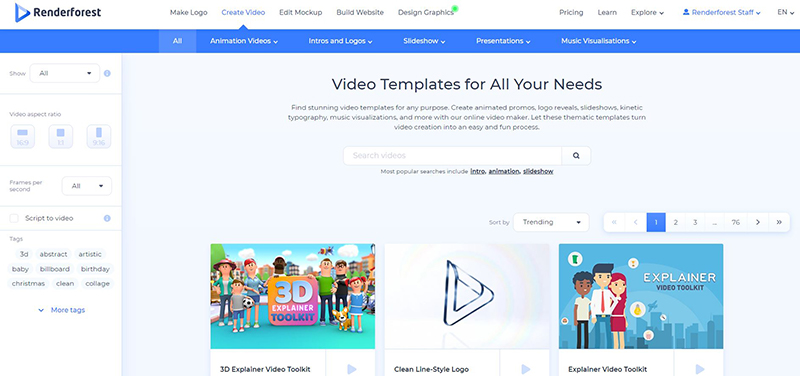
Select the template you need and click “Create now” to start. We’ve used the “Modern Infographics Pack” template to create our video.
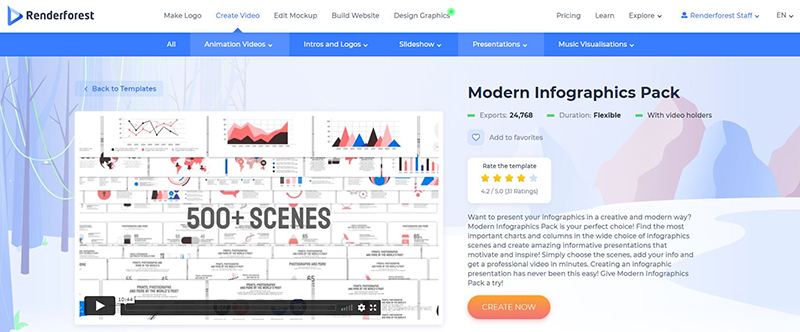
Our video editor provides two options for creating videos. You can create a new project by choosing the scenes manually or choose from the ready-made videos created by our team.
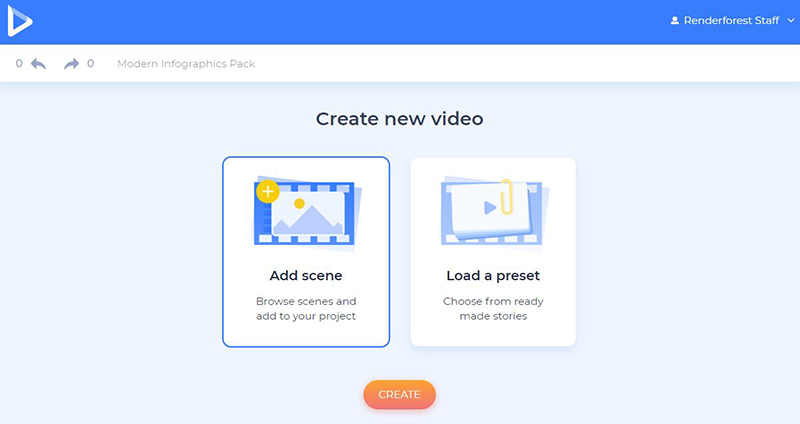
The “Load a Preset” option offers a variety of presets, from where you can choose the one most suitable for your project and start customizing the scenes. Pick the preset and click “Use ready story” to start your project.
We’ve used the “Research Summary Video” preset for our project.
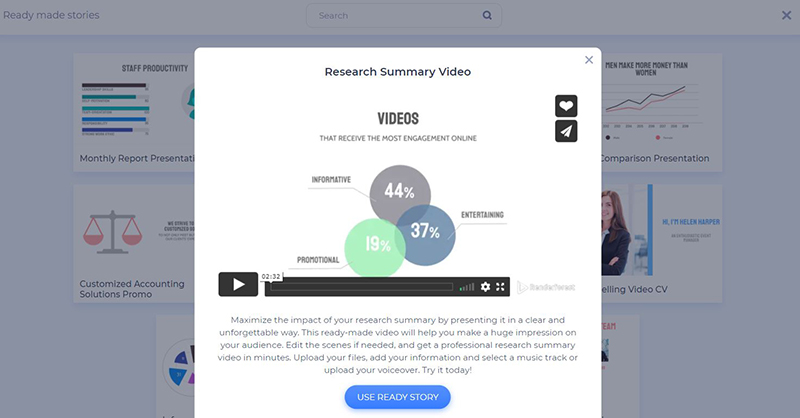
And to create your video project from scratch, click on “Add scene” and start selecting all the necessary scenes manually. This template offers 22 categories with more than 500 scenes. Select the ones you need and click on “Insert” .

After you’ve finished selecting all the necessary scenes, start customizing them. On your timeline, you are free to edit the sequence of your scenes, as well as duplicate, replace, or delete them. Each scene has a Snapshot feature, so you can see how it looks like without previewing the whole video.

You can upload your media files in several ways: via image or video URL, upload them from your device, or pick an already uploaded file from your “Media library”.
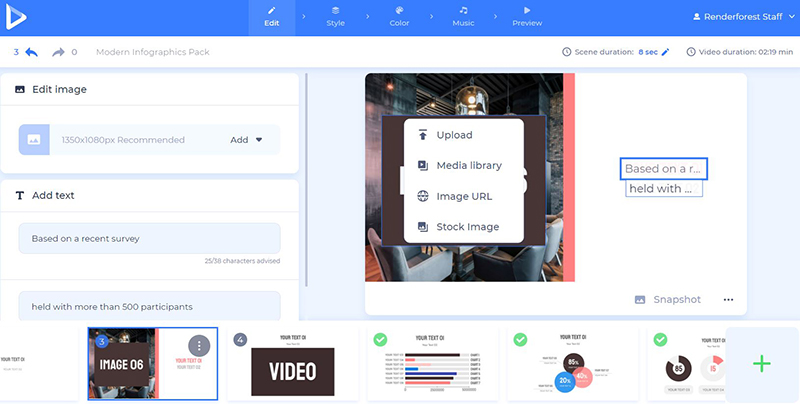
If you don’t have a certain video or image file for your recipe video, click on “Stock footage” and enter a keyword or a phrase to find relevant media files. Once you select a file, click “ Insert ” to confirm it.
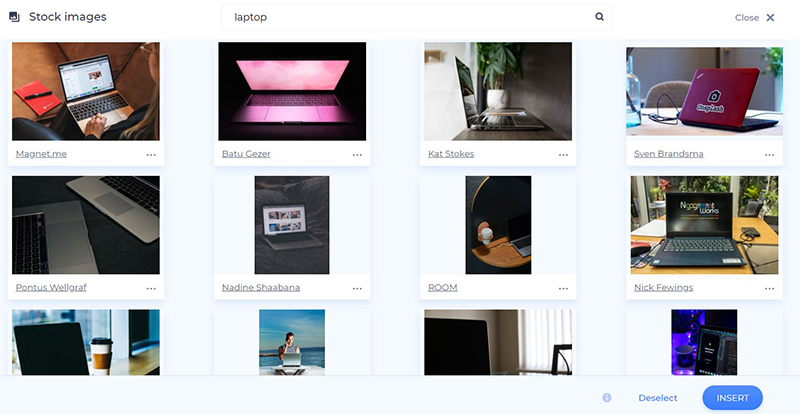
The images can be cropped, rotated, or zoomed in right in the editor. This way you’ll be able to match the image with its frame size perfectly.
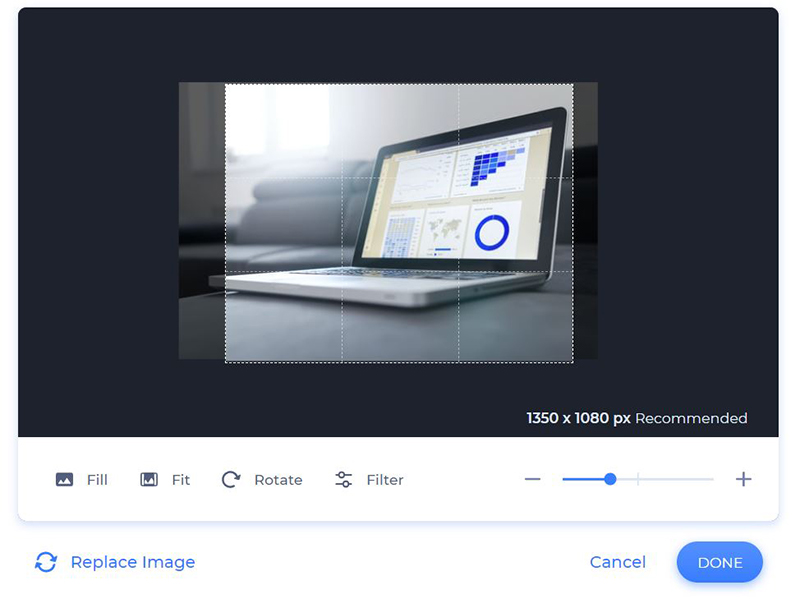
Mute or trim the added video and keep the parts you want to use in your research summary video.
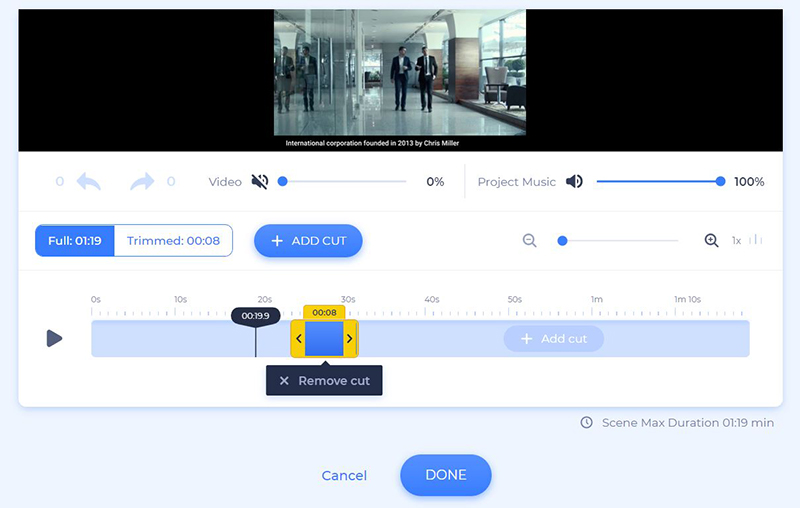
Click on the text holders to type in your text. The text holders have different character limits, so be careful not to exceed them.

Choose the transition of your scenes in the “Style” section, to make your video more active and enjoyable.
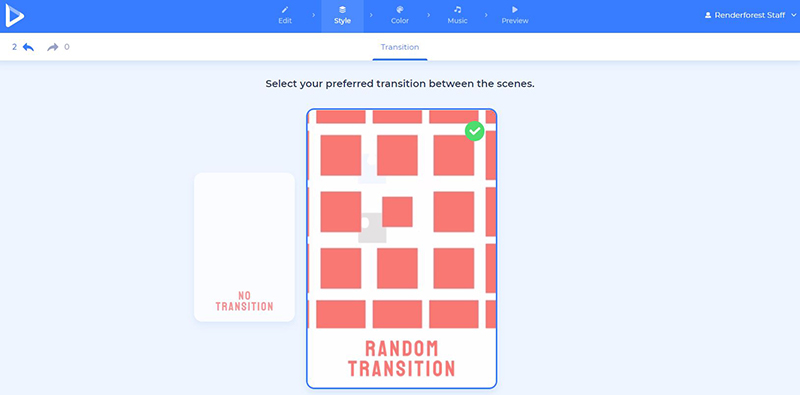
In the “Color” section you customize the colors of your video. Select one of the ready-made color palettes suggested by our design team, or edit the colors of the video components by adding your custom colors.
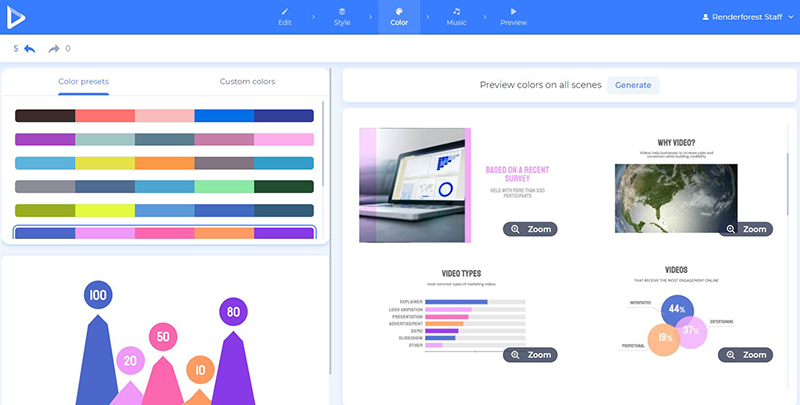
Want to add background music or a voice-over? Go to the “Music” section and pick one of the music tracks available in our library. If you want to use your own music or voiceover, no problem, upload it and add it to your project.
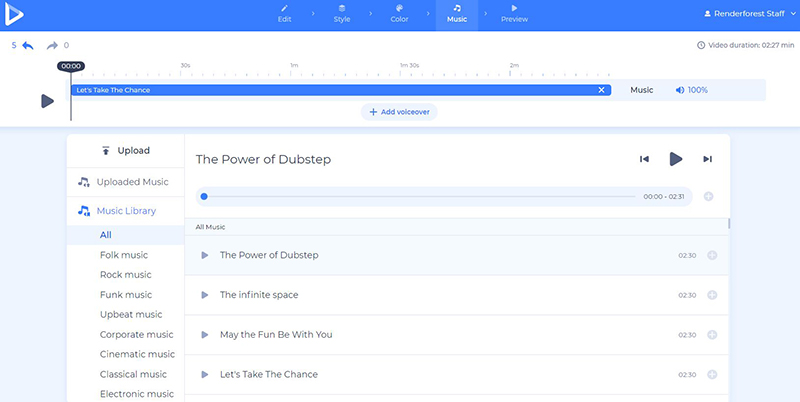
When you fully customize your video, go to the “Preview” section and click on “Free preview” to see the result. We highly recommend previewing your video before you export it in high quality. This way, if you want to edit some parts of your project, you can go back and make all the necessary changes.

There are two ways for you to download your video: The “Free” and the “HD export” versions. The free option comes with a watermark and 360p quality. Meanwhile, with the other “HD export” option, you can choose one of our paid subscriptions and download your video in high quality and no watermark. All the details about our pricing are available here .
Your research summary deserves to be presented in the best possible way. Want to leave an unforgettable impression on people? Share your data through an interactive video and enjoy your success.
Start creating your video now by clicking the button below:
Dive into our Forestblog of exclusive interviews, handy tutorials and interesting articles published every week!
Create Professional

Videos with 1000s of Templates
in Minutes without Technical Skills.

Best video editing software in 2024
14 Jun 2024
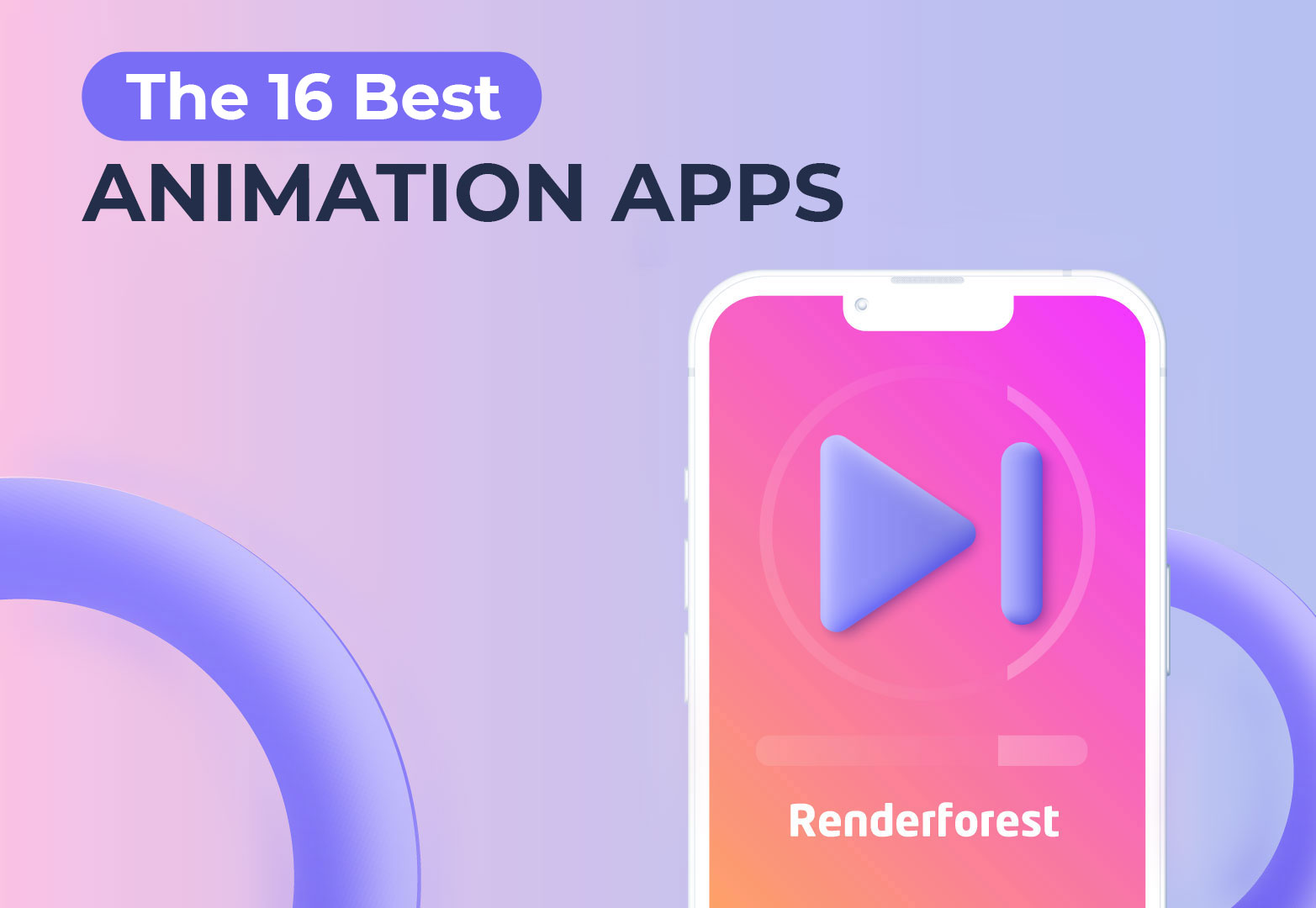
The 16 best animation apps of 2024
13 Jun 2024

How to animate a logo in 5 steps
13 min read
11 Jun 2024


How to Make Popular Research Videos
Summarizing your research into an engaging and easy-to-understand video is an effective way of sharing/promoting research. Gaining popularity among academics and general public alike, these videos can help increase the visibility and discoverability of your research.
To learn more about research videos, click here .
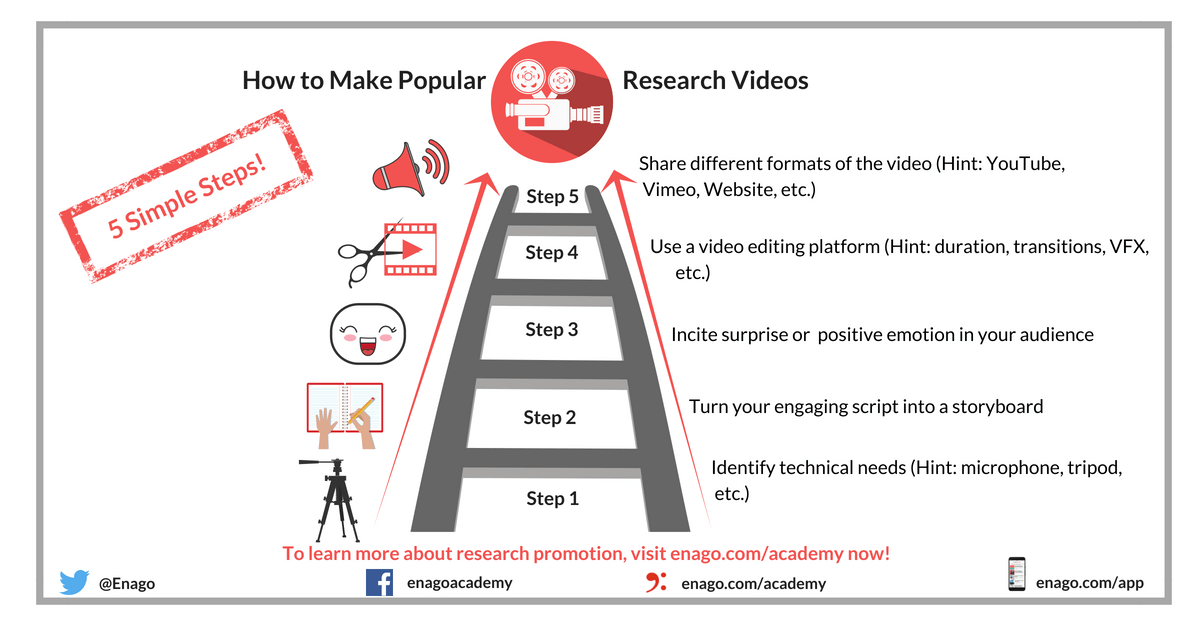
Rate this article Cancel Reply
Your email address will not be published.

Enago Academy's Most Popular Articles

Top 4 Tools for Keyword Selection
Keywords play an important role in making research discoverable. It helps researchers discover articles relevant…

Top 4 Tools to Create Scientific Images and Figures
A good image or figure can go a long way in effectively communicating your results…

Tips to Effectively Present Your Work
Presenting your work is an important part of scientific communication and is very important for…

Tips to Tackle Procrastination
You can end up wasting a lot of time procrastinating. Procrastination leads you to a…

Rules of Capitalization
Using too much capitalization or using it incorrectly can undermine, clutter, and confuse your writing…

Sign-up to read more
Subscribe for free to get unrestricted access to all our resources on research writing and academic publishing including:
- 2000+ blog articles
- 50+ Webinars
- 10+ Expert podcasts
- 50+ Infographics
- 10+ Checklists
- Research Guides
We hate spam too. We promise to protect your privacy and never spam you.
I am looking for Editing/ Proofreading services for my manuscript Tentative date of next journal submission:

What would be most effective in reducing research misconduct?
Author Resources
Reader resources, scholarly community, news and events.
free, unlimited access
advanced features
easy commenting
![how to make a research video [object Object]](https://images.prismic.io/researchsquare/4274dbef-e328-4d9d-a86f-4ac190f351a9_RS+Blog+Image-Making+a+Great+Video+Abstract.png?auto=compress,format&rect=0,0,600,400&w=600&h=400)
author resources
Making a great video abstract [examples and critique], video abstracts have been around since the mid-2000s, but journals and publishers are increasingly using them to help you explain your research to a broader audience. learn more, and view examples of these powerful tools for scientific communication., posted june 1, 2022.
Video abstracts are the audiovisual version of traditional written abstracts. They help you explain your research to a broader audience, as viewers simply click the “play” button – no reading required (unless you have subtitles). Video abstracts have actually been around since the mid-2000s, but journals and publishers are increasingly using them as powerful tools of scientific communication.
Great, but I have absolutely no idea how to make a video!
Indeed, producing videos takes a different skillset and toolkit than writing articles, but it’s getting easier by the year. Even more, skilled production help is available if you have a bit of funding set aside. Outsourced or DIY, it’s valuable to learn what goes into a great video abstract.
In this article, we’ll let you in on key things to understand about producing video abstracts. This includes what they should include, journals that accept them, a critique of an actual video abstract, and a bunch of useful resources.
First, let’s take a deeper dive into what they are and where they came from...
What is a video abstract?
A video abstract is the audiovisual version of conventional abstracts. Video abstracts explain the why, the how, and the main findings of a study in a video typically no more than 5 minutes. You might think of them like the sneak previews at the movies.
However, unlike written research abstracts, video abstracts let you add in some of your personal views on your research. You can also explain complex concepts in a way that’s appealing to visual people (and easily distracted people). Video abstracts also try to encourage the audience to read the entire article to get all the details on your research.
When did video abstracts start?
Since 2007, the Journal of Visualized Experiments ( JoVE ) has published peer-reviewed, professionally videoed experimental procedures. These are given together with traditional full-text articles. JoVE can probably be considered the first example of video abstracts. They’re now available on YouTube.
Here’s an example:
Source: JoVE (Journal of Visualized Experiments) (2022, February 19). Metagenome and Metatranscriptome Sequencing.
It makes total sense that a written journal on visual processes used video. There’s no Hollywood magic in the videos – they’re factual and pragmatic.
A more accessible version of video abstracts started with the first video released in an open format on YouTube in 2009 by the journal Cell . It summarized an article about using animal models to study the evolution of human language. It’s only three and a half minutes long and uses plain language easily understandable by non-specialists.
Watch it here.
Source: Cell Press (2009, May 22). Probing the evolution of human language in a model organism.
This also is not elaborate, but it’s a nice edited video with a mix of science and commentary.
Journals and editors have continued to realize video abstracts are useful marketing tools to raise the visibility, impact, and citations of full-text articles. Indeed, a strong positive correlation has been found between the number of views of a video abstract and the number of reads of the corresponding article.
Advantages of presenting your research in video abstracts
These are some of the main advantages that video abstracts have over the traditional written abstracts and articles. These include:
- You can more effectively show and explain the main conclusions and highlights of your research.
- You can increase citations. According to one study, video abstracts have a positive impact on the number of citations of an article .
- By reaching a broader audience and having a visual documentary of your work, you might increase the chances of receiving funding. For that same reason, potential employers might also be impressed.
- You can describe 3D and dynamic phenomena without simplifying them to a 2D image, or a written description.
What contents should a video abstract include?
Although you don’t usually need to stick to a strict format for your video abstract, some elements are consistently used because they follow a logical order. The same logic applies to written abstracts: lay out the information in a predictable way so the reader (in this case, viewer) finds what they expect to find:
- Introduction: Describe the problems or questions you addressed. What was the gap in the literature? Why did it need filling?
- Methods and results: How did you tackle the research question? How did you get the data? Explain the methods you used to solve the problem and the results that you got out of them. It’s important that you illustrate this part with clear, representative images that a viewer can easily understand. They can be technical, too. You don’t have to “dumb it down.” Like a written abstract – it’s accessible, but it’s also highly accurate and true to the science.
- Conclusions and summary: Highlight the most important conclusions and summarize your work as a take-home message.
- Call for action: Encourage your viewer to download the full article and read it. Add a direct link to your article’s page on the journal’s website. Don’t make them search for it. Remember that a goal of video abstracts is to increase the readership, the impact of your research, and, hopefully, the number of times you’re cited. Getting other researchers to download your article is the first step to cite it (just like a sneak preview is designed to make you want to watch the whole movie).
How long should it be?
A video abstract’s length depends on the journal’s guidelines. For most journals, it’s less than 5 minutes. For example, Taylor & Francis recommends up to 2:20, the American Academy of Pediatrics and British Medical Journal (BMJ) set a maximum of 4 minutes, Cell suggests a maximum of 5 minutes and the New Journal of Physics recommends 3–4 minutes long.
In sum, they’re short, but there’s variety. And this underscores how video abstracts are still evolving as a medium. A written abstract is around 250 words most of the time, with or without subheadings and in the same order. A video abstract has more leeway.
When and where do you use a video abstract?
Video abstracts are relatively common in the STEM fields. Within that, there’s no specific trend in specific fields. It depends on the journal and publisher. The format is less common in the social sciences or humanities. Perhaps that owes to the more theoretical and less visual nature of HSS studies, or to the critical need to anonymize personal data.
That said, studies in areas like industrial psychology and architecture would seem a great fit for a video abstract. See what’s available and factor it into your journal decision.
Academic journals publish video abstracts either directly on their websites or on general platforms, mainly YouTube. Following are just some of the increasing number of journals accepting video abstracts, and publishing them on YouTube, their own websites, or both:
- Biotechnology & Bioengineering
- Clinical Gastroenterology and Hepatology
- Clinical Ophthalmology
- Current Biology
- Developmental Cell
- Drug Design, Development and Therapy
- Environment Science and Technology
- European Journal of Neuroscience
- International Journal of Nanomedicine
- International Journal of Women’s Health
- Journal of Number Theory
- Neuropsychiatric Disease and Treatment
- New Journal of Physics
- Patient Preference and Adherence
How to make a video abstract
As mentioned, there are many styles to follow, and video abstracts are evolving.
Best practices
Despite their changing nature, there are some common aspects that can turn your video abstract into something more engaging and effective:
- Keep it short and, generally, don’t exceed 5 minutes. Attention spans drift off if it’s longer.
- Keep it clear and natural, as if you’re explaining your work to your colleague in the lab next to yours.
- Use accessible vocabulary and limit highly specific jargon.
- Pay attention to the video quality, but don’t forget about the audio. Avoid any background noise that may distract your viewer. You don’t need a professional mic setup for this. You can use a clip-on microphone or a good desk mic.
- An image is better than 1,000 words. You’re on video now, so use it. Complement what you say with pictures or clips of video (and make sure you have the rights to use the video).
- Minimize the number of complicated figures or amount of raw data. The viewer can get distracted trying to interpret them. You’ll hold their attention if you show images that are straightforward and readily understandable.
- Make sure any text can be read, especially if you show graphs or slides. Consider that not everyone will watch your video abstract on a huge PC screen. Think of those watching it on their phone.
Where to put yourself and your voice in a video abstract
With these general rules in mind, choose if you want to appear in the video. In the most traditional style, you (and/or your colleagues) talk in front of the camera. In this case, use visual supporting materials showing images, graphs, etc., as support. You can also choose not to be in front of the camera and, instead, show animations, a slides presentation, or video clips, while you narrate the content of the abstract.
If you’re not fond of watching yourself or hearing your voice, get someone else on the team to do it. Or hire a freelance narrator.
Writing a script will help you keep your focus, follow a structure, and not forget important information. But don’t read every word on a screen while you record the video. It won’t come across as natural. Apply the same rules you’d apply for an in-person presentation. And the great thing is, if you mess up, you can do it again until you get it right.
An example of a good video abstract
If you’re going to discuss termite mounds, what’s better: write about them at length or show them?
A visual phenomenon is made to be seen. But you’re a researcher, too, so you have to focus on the science. This particular research is not only in a very cool area, the researchers go to it, with a drone, to make their video abstract.
Credit: Cell Press (. Vast 4,000-Year-Old Spatial Pattern of Termite Mounds/Curr. Biol., Nov. 19, 2018 (Vol. 28, Issue 22)
In fact, it’s the most viewed video on Cell Press’s YouTube channel. In less than 3 minutes, the author describes the research on the patterns followed by up to 4,000-year-old termite mounds that cover an area in Brazil similar that’s about the size of England!
It’s unclear if the people in the video are the authors or the narrators, though it doesn't detract from the video. The narrator uses simple, jargon-free language. Also, pay attention to the structure: an introduction describing the area, the mounds, and the authors’ questions; their methods, and their possible explanation.
The authors knew they had to highlight the most striking aspects of their topic to engage the viewer: the vast size of these insect constructions, how they extend underground, and the huge area they occupy.
One slight shortcoming of the video is that over half of it is spent describing the structures, which are indeed impressive. In contrast, the methods used, and the conclusions extracted are packed into the video’s last seconds.
Those matters aside, the authors have made this video abstract so interesting that well over 100,000 people were curious about it. That’s really good impact. We’re not all so fortunate to work with visually stunning science, and we may not get 100K viewers on YouTube, but we can still learn to highlight the best points and explain them accessibly and with good video work.
Resources for making your video abstract
- Cell Press video abstract guidelines
- Make a video abstract for your research , University of Oklahoma
- Some tips for producing good video abstracts
- JoVE , a peer-reviewed video journal
- Animate Your Science Blog , ways to make video abstracts - with examples
Can someone make my video abstract for me?
Yes, we can. Research Square’s Research Promotion services will help you get the word out about your research in powerful ways beyond print publication.
Our Video Abstract service is a completely customized package of animation and narration about your science. We work with you to tailor a beautiful visual presentation like this:
So if you’ve read this article but you’re just too pressed for time, overwhelmed with other duties, and want to be sure your video abstract attracts viewers, look into the Research Square Video Abstract service . We’d love to help you tell your story.
How to Share Your Research Video
The Lay Summary: Communicating Research in Plain Language
Building Trust in Information Through Standards and Best Practices
Case Study: A Journey in Preprinting
Share this article with your colleagues
Have a language expert improve your writing
Run a free plagiarism check in 10 minutes, generate accurate citations for free.
- Knowledge Base
- Starting the research process
A Beginner's Guide to Starting the Research Process

When you have to write a thesis or dissertation , it can be hard to know where to begin, but there are some clear steps you can follow.
The research process often begins with a very broad idea for a topic you’d like to know more about. You do some preliminary research to identify a problem . After refining your research questions , you can lay out the foundations of your research design , leading to a proposal that outlines your ideas and plans.
This article takes you through the first steps of the research process, helping you narrow down your ideas and build up a strong foundation for your research project.
Table of contents
Step 1: choose your topic, step 2: identify a problem, step 3: formulate research questions, step 4: create a research design, step 5: write a research proposal, other interesting articles.
First you have to come up with some ideas. Your thesis or dissertation topic can start out very broad. Think about the general area or field you’re interested in—maybe you already have specific research interests based on classes you’ve taken, or maybe you had to consider your topic when applying to graduate school and writing a statement of purpose .
Even if you already have a good sense of your topic, you’ll need to read widely to build background knowledge and begin narrowing down your ideas. Conduct an initial literature review to begin gathering relevant sources. As you read, take notes and try to identify problems, questions, debates, contradictions and gaps. Your aim is to narrow down from a broad area of interest to a specific niche.
Make sure to consider the practicalities: the requirements of your programme, the amount of time you have to complete the research, and how difficult it will be to access sources and data on the topic. Before moving onto the next stage, it’s a good idea to discuss the topic with your thesis supervisor.
>>Read more about narrowing down a research topic
Receive feedback on language, structure, and formatting
Professional editors proofread and edit your paper by focusing on:
- Academic style
- Vague sentences
- Style consistency
See an example

So you’ve settled on a topic and found a niche—but what exactly will your research investigate, and why does it matter? To give your project focus and purpose, you have to define a research problem .
The problem might be a practical issue—for example, a process or practice that isn’t working well, an area of concern in an organization’s performance, or a difficulty faced by a specific group of people in society.
Alternatively, you might choose to investigate a theoretical problem—for example, an underexplored phenomenon or relationship, a contradiction between different models or theories, or an unresolved debate among scholars.
To put the problem in context and set your objectives, you can write a problem statement . This describes who the problem affects, why research is needed, and how your research project will contribute to solving it.
>>Read more about defining a research problem
Next, based on the problem statement, you need to write one or more research questions . These target exactly what you want to find out. They might focus on describing, comparing, evaluating, or explaining the research problem.
A strong research question should be specific enough that you can answer it thoroughly using appropriate qualitative or quantitative research methods. It should also be complex enough to require in-depth investigation, analysis, and argument. Questions that can be answered with “yes/no” or with easily available facts are not complex enough for a thesis or dissertation.
In some types of research, at this stage you might also have to develop a conceptual framework and testable hypotheses .
>>See research question examples
The research design is a practical framework for answering your research questions. It involves making decisions about the type of data you need, the methods you’ll use to collect and analyze it, and the location and timescale of your research.
There are often many possible paths you can take to answering your questions. The decisions you make will partly be based on your priorities. For example, do you want to determine causes and effects, draw generalizable conclusions, or understand the details of a specific context?
You need to decide whether you will use primary or secondary data and qualitative or quantitative methods . You also need to determine the specific tools, procedures, and materials you’ll use to collect and analyze your data, as well as your criteria for selecting participants or sources.
>>Read more about creating a research design
Here's why students love Scribbr's proofreading services
Discover proofreading & editing
Finally, after completing these steps, you are ready to complete a research proposal . The proposal outlines the context, relevance, purpose, and plan of your research.
As well as outlining the background, problem statement, and research questions, the proposal should also include a literature review that shows how your project will fit into existing work on the topic. The research design section describes your approach and explains exactly what you will do.
You might have to get the proposal approved by your supervisor before you get started, and it will guide the process of writing your thesis or dissertation.
>>Read more about writing a research proposal
If you want to know more about the research process , methodology , research bias , or statistics , make sure to check out some of our other articles with explanations and examples.
Methodology
- Sampling methods
- Simple random sampling
- Stratified sampling
- Cluster sampling
- Likert scales
- Reproducibility
Statistics
- Null hypothesis
- Statistical power
- Probability distribution
- Effect size
- Poisson distribution
Research bias
- Optimism bias
- Cognitive bias
- Implicit bias
- Hawthorne effect
- Anchoring bias
- Explicit bias
Is this article helpful?
Other students also liked.
- Writing Strong Research Questions | Criteria & Examples
What Is a Research Design | Types, Guide & Examples
- How to Write a Research Proposal | Examples & Templates
More interesting articles
- 10 Research Question Examples to Guide Your Research Project
- How to Choose a Dissertation Topic | 8 Steps to Follow
- How to Define a Research Problem | Ideas & Examples
- How to Write a Problem Statement | Guide & Examples
- Relevance of Your Dissertation Topic | Criteria & Tips
- Research Objectives | Definition & Examples
- What Is a Fishbone Diagram? | Templates & Examples
- What Is Root Cause Analysis? | Definition & Examples
Get unlimited documents corrected
✔ Free APA citation check included ✔ Unlimited document corrections ✔ Specialized in correcting academic texts
Weekly hours for all locations
Make a Video Abstract for your Research
← go back to the impact challenge table of contents.

Professional Video Camera , CC BY 4.0
Video abstracts are a great way to explain your work to the public and researchers outside of your field. To paraphrase , they’re like value propositions on steroids. These 3-5 minute videos allow you to sum up what you’ve accomplished and documented in a journal article and, crucially, why it’s important to the world . You can use video abstracts to illustrate concepts explained in your article, to “introduce viewers to the equipment and tools you have used in your research and engage with your audience in a more informal manner,” explains IOP Press . An increasing number of publishers are adopting video abstracts as a great way to market research articles, and in less than an hour you can create one of your own. In this week's challenge we’ll walk you through the basics of creating a video abstract for a journal article: how to write a script, record the video using common equipment, and share your video to get maximum visibility for your research.
Step 1. Learn what makes a good video abstract
Here are some award-winning and highly ranked video abstracts:
- GBV 5-Minute Science Fair [Public Health & the Pandemic of Violence Against Women] : a straightforward video of a researcher describing her study of domestic violence among Latino immigrant communities in Washington DC. It has good production value – well lit, easy to hear, plus some custom titles and credits added to the beginning and ending – but is simple enough in concept that anyone could pull it off.
- Dangling-bond charge qubit on a silicon surface : in just under five minutes, this video abstract sets a stage for what qubits are and why this particular study advances our knowledge of qubits. The researchers reuse computer-generated graphics and figures from their paper to illustrate the concepts they explain in the video, to great effect.
- The Bacterial Effector VopL Organizes Actin into Filament-like Structures : this video features three researchers describing their paper with the aid of paper and pen, protein models, and some sweet action shots in the lab. It’s a highly technical explanation that can be a bit dry at points, but it still manages to explain the study in a manner that non-specialists can understand. It’s successful, because the authors explain things well and go out of their way to illustrate concepts for the viewer.
Viewers need to know how your research is relevant to their lives, their universe, or the advancement of knowledge in your field. But you can’t just say anything in your video abstract. Aim to keep your video simple and short, refrain from using jargon, and – if possible – tell a story that will hook your viewers within the first 30 seconds and keep them watching until the end. With these principles in mind, let’s get started!
Step 2. Gather your equipment
The basic equipment you’ll need is readily available.
- A computer, webcam, and microphone: Most newer model laptops come with webcams and microphones built-in. If you don’t have one, you can borrow one from the Circulation Desk at Bizzell . You can also use a desktop computer with a standalone webcam and microphone, if need be. And if you plan to do a simple video abstract (like the GBV point-and-shoot video featured above), a smartphone that can record video will do in a pinch.
- Video recording software: If you’ve got a late model MacBook, the pre-installed QuickTime Player software can be used to create a simple screencast , and if you’ve upgraded to Mojave you can use Shift-Command-5 . Then iMovie can be used to edit any videos you create. Otherwise, check out this list of best screencasting tools for both Windows and Mac options.
- A passionate explanation of your research: Video abstracts are only as good as the stories they tell. No amount of production value can make up for a dispassionate explanation or lack of relatability to the viewer’s own life. In the next step, we’ll share some research-backed tips on how to communicate your results, but at the very least, you’ll need the kernels of the story from which we’ll make this video abstract bloom.
Once you’ve got all that together, it’s time to choose a format and write your script.
Step 3. Choose your format
Do you want to do a point-and-shoot video that’s simply 2 minutes of you describing your paper and why it rocks? Would you prefer to structure your video abstract like a lightning-talk screencast, with you explaining slides and videos that illustrate your points from off-camera? The format of the video you’ll create will likely be dependent upon what equipment and technical expertise you have on hand. And your script will be dependent upon your video’s format. So, catalogue what you’ve got available and decide upon a format. Because we’re getting to the good stuff next: your video’s script.
Step 4. Write the script
You’ll use your script to narrate the story of your video. It doesn’t have to be written out, word-for-word; if you’re comfortable ad libbing, a simple outline will do. More than anything it is important that you practice two or three times before you start filming. You’ll be amazed at the difference a few low pressure practice sessions make.
Create an outline
Your outline should follow a basic structure.
- A problem statement
- A quick explanation of how your research solves that problem
- An in-depth explanation of your study and results
- Reiterate what the problem is, how you solved it, and why the world’s a better place now
- Invite the viewer to become a reader
Once you’ve got a solid outline, you’ll need to decide if writing a full script will be useful for the video. If you’ve decided to do a point-and-shoot video , an outline of your talk is probably your best bet. It will keep you on your main talking points, while avoiding sounding stiff or over-rehearsed. Doing a lightning-talk screencast instead? Use your outline to create a slide deck, and then write out what you’re going to say, word for word, so you can read it while doing the screencast. If you decide to write a full script, keep in mind that 120-150 words roughly translate into a minute of video. You’ll want to keep your video to 3-5 minutes, so plan to write a script that’s 750 words or less. Need some inspiration? A great example script can be found on TheScientistVideographer.com .
Step 5. Record your video abstract!

Image © Dave Dugdale Licensed CC BY-SA 2.0
If you’re recording your video abstract for sharing on a publisher’s website, you’ll need to record your video according to their guidelines. Be sure to double check their limits on the video’s length, quality, and how and where it’s shared. Pay close attention to the quality of sound and lights. Videos that are difficult to watch won’t get many viewers. The University Affairs blog recommends using “a lapel microphone, ideally, or else a very quiet room. Ensure that lights are facing the speaker and avoid backlighting, which happens when you situate the interview subject against a window.” And if you’re creating a lightning-talk screencast video, consider paying a professional voiceover artist to narrate it. They often have the experience and audio equipment that will make your video sound professionally produced, and you can hire one easily on Fiverr . If you’d rather do the voiceover yourself, keep Videobrewery’s advice in mind:
Once your video has been recorded, you can choose to edit it with your video editing software. This is a good opportunity to remove your tangents and flubbed lines, but it might require you to learn a new skill. Sometimes it’s just easier to record a second take instead. One final option that’ll make your video stand out: add intro and outro music that’s licensed for reuse, which you can find on dig.CCmixter , the Internet Archive (make sure the usage rights include a Creative Commons license), or simply run a search from Creative Commons on both ccMixter and Soundcloud . If you’re unable to find music among all the openly licensed options, you can also purchase music cheaply from AudioJungle .
Step 6. Set up captions/subtitles
Captions or subtitles are a necessary addition to your video abstract. They will make your abstract accessible both to the deaf and hearing impaired community, as well as to individuals who have an easier time reading than listening to the language you choose for your video. If you have the technical acumen to add these yourself, you probably already understand how to do it. If you do not trust your abilities, do not fear. As always, we have a solution for you. If you will be uploading your video to YouTube (highly recommended), you can automatically add closed captions to your video. YouTube has restrictions based on the time length of the video, but if you are within the video length we recommended above, you should be fine. For an in depth guide on the ins and outs of adding captions, automatically or by hand, take a look at this video by Alan Spicer. If you are choosing to forego the YouTube option, or just do not have time to deal with adding the closed captions yourself, there are several businesses ready to help. For example, Rev.com will accurately add closed captions to your video files for one dollar per minute, and they will often deliver the final product to you within twenty four hours. Rev is a great way to add subtitles to your video quickly and easily. Now let’s get your video to the public!
Step 7. Upload the video
Where to share it
Two popular platforms for video sharing are YouTube and Vimeo. Both can be used to track views and likes for your video, and they both allow you to copy and paste simple codes to embed your video in other websites. Neither offers long-term preservation, so we recommend that you back-up your video abstract by uploading it to SHAREOK where you can link out to the content on YouTube or Vimeo. For more information about uploading your work to SHAREOK, see last week’s OU Impact Challenge activity, Upload Your Work to SHAREOK .
- YouTube: YouTube is free and easy to use, but it has its drawbacks: they reserve the right to place ads on and alongside your videos.
- Vimeo: Vimeo is also fairly easy to use and offers a well-designed, ad-free viewing interface. Its main drawback is that you have to pay for video uploads greater than 500 MB in size . You can disable comments and allow viewers to download your video, if you wish.What to include
What to include When you upload your video, be sure to include a descriptive title (one that matches your article is ideal), a 2-3 sentence description of your video abstract’s content, and a full citation to your paper (including a link to the freely-accessible copy that you uploaded to SHAREOK , if it’s been published in a toll-access journal).
Step 8. Promote your awesome new video abstract
Now that your video is online, let’s get it some viewers! Some good places to share your video on the Web include:
- On the article homepage: if the journal allows it, ask them to embed your video next to the written abstract for your paper. That way, potential readers get a more engaging glimpse of what your paper is about – beyond what appears in the written abstract.
- Your website: embed your video on your website’s homepage, or on the Publications or Research pages.
- Your LinkedIn: Add a link to your abstract on your LinkedIn page to show anyone who comes across your profile what kind of work you are doing.
- Your blog: share the video along with a link to your publication and a transcript of your video, adapted into a blog post.
- Twitter and Facebook : these social media platforms were practically made for sharing video with the public. Share a link with your next update and both platforms will automatically embed it for your followers and friends. It may even be worth it to make a tweet with your video abstract your “pinned” tweet. That way, everyone who comes to look at your account will see it front and center.
- We Share Science: If you’re in a STEM discipline, this video aggregator allows you to share your science video abstract with other scientists and students. You can also follow other authors and video creators on the site to stay on top of the best video abstracts – useful for discovering what works well so you can borrow it to use in your own videos!
Limitations
The biggest limitation for this week’s activity has to be the time required. You’ll have to put in a lot of work to create a short five minute video. However, it will be worth it . A video abstract highlights your research like nothing else. If you are still uncertain about using editing software, try searching for tutorials for your specific software on Youtube, or ask for help at the Consultations @ OU Libraries in Bizzell.
Choose an article you’ve written and make a plan to create a video abstract for it. Budget out time to start building it, and pick out an editing software you are familiar with or seems intuitive if it is all new to you. Once you have your groundwork laid, you can get started with writing your script and shooting it. And once you’ve created it, share it on at least one of the platforms or websites we mention above.
Content for the OU Impact Challenge has been derived from “ The 30-Day Impact Challenge ” by Stacy Konkiel © ImpactStory and used here under a CC BY 4.0 International License. The OU Impact Challenge is licensed CC BY 4.0 , unless otherwise noted.
How to do Research for YouTube Videos
To succeed in any new business, you need to do either of these two things — build something that people want but no one has made it before. Or if it already exists then make the better version of it.
Now, this also holds true for YouTube. If you are just starting a new channel, either make videos that no one is making (and that people want to see it) or make your videos better than the existing players.

Now let’s be honest, if you are just starting a YouTube channel, you can not compete with the settled players. You don’t have the resources or the experience to do that.
So the next best thing you can do, to get notice in the crowded world of internet is —
Make something with high demand and low supply.
Now obviously, it is much easier said than done. Ninty percent of this high demand low supply stuff is spam or unreliable. Like how to lose 20 pounds in a week, only secret that will make you a millionaire etc etc.
However, if you are constantly looking for that high demand topic and making videos on it, you will eventually get notice. One of that video will go viral and bring good traffic. Now if all the other videos are equally good. Your channel will grow, very fast.
Note: When I say, you should cover hot topics, I don’t mean you should cover anything that’s popular. But only go for the topics that you find interesting and are also popular. Something that comes under your area of expertise.
So how do you find high demand and low supply topic?
Well, you can’t predict the success of any YouTube video. There is no single recipe to make a viral video (or else everyone would be doing that)
However, there are few metrics that can help us identify high demand and low supply topic on YouTube. Or at least, it will give you a better idea about your target audience.
I do this for most of my videos. It helps me to find how much is the demand, what is age and demographic of my target audience, and what they want in a video.
So here is how to do it ( video tutorial at the end of the video)
Step 1: Make a list of topics on which you would like to make videos. And then run one by one in YouTube search.
For instance – say one of the topic is how to meditate . So search this keyword on YouTube. You will see several results. We have to analyse them.
Step 2: Now if you see too many top rank videos that are old videos with high views count . This means it’s the right topic. You see old video means low supply and h igh views count means high demand. Basic economics.

But, we need to analyse them further. So go through each video one by one. Start by clicking the first video and look for following details.
>If the uploader has low subscriber base — it means good search traffic
> If the number of unlikes is more than 10 percent of likes — it means viewers are not satisfied with the content or presentation. This is a window of opportunity for you. Diagnose the problem and make sure it doesn’t happen in your video.
> Scroll down to the bottom of the video and click on the more option. There you will see video stats click on that and change the filter to daily — if the number is high, people are still looking for this topic.

See the steps in action in this video tutorial

Mrinal Saha
Mrinal is a tech geek who spends half of his day reading and writing about tech. While the nights are spent on shooting or editing YouTube videos. Feel free to geek out with him on-
You may also like
Can someone see what i search on google..., these apple watch models will get the watchos..., will your ipad model get ipados 18 update..., how to create polls on discord channel, 6 fixes for samsung tv or monitor stuck..., a guide to using phone link on windows..., what is secret mode in samsung internet and..., you can share location using this siri shortcut..., this siri shortcut for iphone can help when..., what does the bell icon mean on various..., leave a comment cancel reply.
You must be logged in to post a comment.
Misleading GOP videos of Biden are going viral. The fact-checks have trouble keeping up.

More Americans may think President Joe Biden tried to sit on a nonexistent chair the other day than know the boring truth that there was, in fact, a chair .
The chair-that-was-there was just one of many quick video clips the conservative media ecosystem willed into virality over the past two weeks, leaving fact-checkers and Biden’s team with little chance to catch up.
The Republican National Committee, major conservative media outlets and right-wing influencers have succeeded in blasting out videos that they claim show “proof” of Biden’s wandering off , freezing up or even filling his pants with a substance commonly represented by a brown swirl emoji.
Independent fact-checkers and the Biden campaign have pointed out that the videos, while they are un-doctored by artificial intelligence, tend to crumble under even basic scrutiny, such as when the moments are viewed in context or from wider camera angles .
“Fresh off being fact checked by at least 6 mainstream outlets for lying about President Biden with cheap fakes, Rupert Murdoch’s sad little super PAC, the New York Post, is back to disrespecting its readers and itself once again,” White House spokesperson Andrew Bates said in a statement in reference to a video of Biden at a fundraiser with former President Barack Obama over the weekend that landed on the cover of the Post, a conservative tabloid.
While "deepfakes" are misleading audio, video or images that are created or edited with artificial intelligence technology, a "cheap fake," according to researchers Britt Paris and Joan Donovan, is a " manipulation created with cheaper, more accessible software (or, none at all). Cheap fakes can be rendered through Photoshop, lookalikes, re-contextualizing footage, speeding, or slowing."
Still, even if they are deceptive, the videos nonetheless play into voters’ existing concerns about Biden’s age and are tailor-made for internet virality, meaning busy voters may be more likely to encounter the brief incendiary clips than the more rigorous fact-checks that chase them.
“The lie is sprinting the 100-meter dash and the fact-check is taking a stroll on the beach. So it’s never going to catch up. And it’s never going to have the same reach,” said Eric Schultz, a Democratic strategist and Obama spokesperson who on Sunday publicly called out the Post’s characterization of the fundraiser as false.
Last week, Republicans pushed a video of Biden in Europe attending the Group of Seven summit in which he allegedly “wandered off” in a confused haze before Italy’s prime minister pulled him back. Uncut video and shots from wider angles showed Biden was greeting a parachutist who had just landed as part of the ceremony.
The controversy generated by the video grew so large that British Prime Minister Rishi Sunak was asked to give his eyewitness account of the moment.
“They had all landed, and he was being very polite. And he just went over to kind of talk to all of them individually,” Sunak told reporters .
Before that, the RNC’s opposition research account suggested Biden was having a medical incident because he was not dancing at a Juneteenth event, though Biden has long said he is not much of a dancer and barely danced at his inaugural ball in 2021.
At the fundraiser in Los Angeles, Biden and Obama were waving to supporters after having received a standing ovation when Biden stared into the audience for a moment before the more punctual Obama signaled it was time to leave the stage. Several people at the event said they did not recognize the New York Post’s interpretation that Biden appeared to "freeze up."
'A pattern of behavior'
Republicans are unapologetic about the individual videos — despite the fact-checks from mainstream media they distrust.
“It’s a pattern of behavior. It’s not like it’s one instance,” Trump campaign spokeswoman Karoline Leavitt said in an interview. “It’s not like we’re making these videos. This is Joe Biden in real time. We’re just putting it out there for the world to see.”
Asked about the clipped video that Republicans said showed Biden trying to sit in a chair that did not exist (in fact, it was just hidden from view by the camera angle), Leavitt said, “The videos speak for themselves.”
“It’s outrageous that the words ‘cheap fake’ [are] even being used," she said. "There’s nothing cheap or fake about these videos. They are real clips of Joe Biden acting bizarrely.
“The Biden campaign’s entire strategy is to convince people not to believe their own eyes,” she added.
The spread of the videos underscores what academics say could be a particularly tumultuous election cycle . Many major social media platforms have rolled back the few checks and balances on the spread of false or misleading information under pressure from Republicans . Meanwhile, the power and reach of just a handful of accounts on X can spread talking points to millions of people that is then picked up by more mainstream conservative media.
Taking liberties with video editing — or simply misrepresenting what is happening in a video — is nothing new. But former President Donald Trump’s takeover of the Republican Party has pushed the party further across the hazy divide between spin and mendacity, while technology has allowed for clips to be cut and broadcast constantly.
Reaching voters who do not consume much political news is a challenge in the best of cases, and it is made even harder when organizations try to reach the same voters a second time to try to change their views about a stray piece of political content they previously encountered.
Conservative media outlets disseminating such clips include not only famously ideological ones, like Fox News , but also the vast network of local TV news stations owned by Sinclair Broadcasting, dozens of which re-packaged identical versions of the same headline about Biden’s appearing to freeze.
Few in conservative media have offered any resistance to the onslaught of videos. Howard Kurtz, a Fox News host and media journalist, is one of the few notable outliers , having called out the New York Post and fellow host Sean Hannity for their coverage of the G7 video.
And internet platforms’ algorithms and their users’ organic behavior tend to reward the surprising and controversial while ignoring the mundane.
'We can't stop them from doing this'
Democrats’ strategy for dealing with the videos is twofold, according to multiple people familiar with the thinking of the Biden campaign, the White House and allied outside groups.
First, they will try to contain them to the conservative media ecosystem and extremely online spaces of political discourse like X, hoping to prevent them from breaking through into the mainstream as much as possible.
By being aggressive in fact-checking, quickly posting fuller video clips with appropriate context and calling out media outlets that report on them, the White House and the Biden campaign hope to stop them from spreading too far.
“We can’t stop them from doing this. What we can do is fight like hell to get fact-checks and to spread those fact-checks,” said a Biden campaign official who requested anonymity to speak candidly about strategy. “Does it potentially permeate out to independent voters? Yes, and that’s what we’re guarding against and fighting against.”
Second, Democrats are stepping up their own attacks on Trump online, aggressively posting their own made-to-go-viral videos of Trump’s verbal cul-de-sacs, curious tangents and awkward actions.
They include highlighting what they say are Trump’s senior moments, such as one at a rally Saturday night when he said Biden “should have to take a cognitive test” — only to moments later flub the name of the doctor who administered a similar test to him.
Much of it has come from Biden HQ, an account the Biden campaign’s research and rapid-response teams use to blast Trump. For instance, in one clip from the same event , Trump promised to take questions after his speech — “This is different than Joe Biden. He doesn’t take any questions” — but instead left the stage without taking any questions.
Schultz said: “Both candidates are old, but one is coherent and has cogent thoughts. So to the extent that that breaks through, then I think we’ll be OK come November.”
Trump’s campaign has also complained about the Biden campaign’s deceptively portraying videos of its own in the past. That included when Trump told autoworkers there would be a “ bloodbath ” if he is not elected. Trump’s campaign said that the term specifically referred to the auto industry and that Democrats intentionally mischaracterized it by making it appear that Trump was inciting violence.
Still, Democrats up to and including Biden himself — hardly a digital native — seem to understand the challenge of suppressing viral videos that many Americans want to believe.
“The truth is that the way in which we communicate with people these days, there’s very little — there’s so much opportunity to just lie,” Biden said at the fundraiser in Los Angeles. "So much of it on the internet is absolutely a flat-out lie.”
First lady Jill Biden took on the issue of Biden’s age head-on Saturday at an event for seniors in Phoenix: "Joe and the other guy are essentially the same age, so let’s not be fooled."
According to polls, voters so far do not agree with her. And some Democrats seem to be constantly bracing for some major, unedited moment when Biden shows his age.
NBC News’ national poll in late January found three-quarters of voters, including many Democrats, saying they had major or minor concerns about Biden’s physical and mental health.
Alex Seitz-Wald is a senior politics reporter for NBC News.
- Browse All Articles
- Newsletter Sign-Up
Marketing →

- 07 May 2024
- Cold Call Podcast
Lessons in Business Innovation from Legendary Restaurant elBulli
Ferran Adrià, chef at legendary Barcelona-based restaurant elBulli, was facing two related decisions. First, he and his team must continue to develop new and different dishes for elBulli to guarantee a continuous stream of innovation, the cornerstone of the restaurant's success. But they also need to focus on growing the restaurant’s business. Can the team balance both objectives? Professor Michael I. Norton discusses the connections between creativity, emotions, rituals, and innovation – and how they can be applied to other domains – in the case, “elBulli: The Taste of Innovation,” and his new book, The Ritual Effect.

- 29 Feb 2024
Beyond Goals: David Beckham's Playbook for Mobilizing Star Talent
Reach soccer's pinnacle. Become a global brand. Buy a team. Sign Lionel Messi. David Beckham makes success look as easy as his epic free kicks. But leveraging world-class talent takes discipline and deft decision-making, as case studies by Anita Elberse reveal. What could other businesses learn from his ascent?

- 17 Jan 2024
Psychological Pricing Tactics to Fight the Inflation Blues
Inflation has slowed from the epic rates of 2021 and 2022, but many consumers still feel pinched. What will it take to encourage them to spend? Thoughtful pricing strategies that empower customers as they make purchasing decisions, says research by Elie Ofek.

- 05 Dec 2023
What Founders Get Wrong about Sales and Marketing
Which sales candidate is a startup’s ideal first hire? What marketing channels are best to invest in? How aggressively should an executive team align sales with customer success? Senior Lecturer Mark Roberge discusses how early-stage founders, sales leaders, and marketing executives can address these challenges as they grow their ventures in the case, “Entrepreneurial Sales and Marketing Vignettes.”

Tommy Hilfiger’s Adaptive Clothing Line: Making Fashion Inclusive
In 2017, Tommy Hilfiger launched its adaptive fashion line to provide fashion apparel that aims to make dressing easier. By 2020, it was still a relatively unknown line in the U.S. and the Tommy Hilfiger team was continuing to learn more about how to serve these new customers. Should the team make adaptive clothing available beyond the U.S., or is a global expansion premature? Assistant Professor Elizabeth Keenan discusses the opportunities and challenges that accompanied the introduction of a new product line that effectively serves an entirely new customer while simultaneously starting a movement to provide fashion for all in the case, “Tommy Hilfiger Adaptive: Fashion for All.”

- Research & Ideas
Are Virtual Tours Still Worth It in Real Estate? Evidence from 75,000 Home Sales
Many real estate listings still feature videos and interactive tools that simulate the experience of walking through properties. But do they help homes sell faster? Research by Isamar Troncoso probes the post-pandemic value of virtual home tours.

- 17 Oct 2023
With Subscription Fatigue Setting In, Companies Need to Think Hard About Fees
Subscriptions are available for everything from dental floss to dog toys, but are consumers tiring of monthly fees? Elie Ofek says that subscription revenue can provide stability, but companies need to tread carefully or risk alienating customers.

- 29 Aug 2023
As Social Networks Get More Competitive, Which Ones Will Survive?
In early 2023, TikTok reached close to 1 billion users globally, placing it fourth behind the leading social networks: Facebook, YouTube, and Instagram. Meanwhile, competition in the market for videos had intensified. Can all four networks continue to attract audiences and creators? Felix Oberholzer-Gee discusses competition and imitation among social networks in his case “Hey, Insta & YouTube, Are You Watching TikTok?”

- 26 Jun 2023
Want to Leave a Lasting Impression on Customers? Don't Forget the (Proverbial) Fireworks
Some of the most successful customer experiences end with a bang. Julian De Freitas provides three tips to help businesses invest in the kind of memorable moments that will keep customers coming back.

- 31 May 2023
With Predictive Analytics, Companies Can Tap the Ultimate Opportunity: Customers’ Routines
Armed with more data than ever, many companies know what key customers need. But how many know exactly when they need it? An analysis of 2,000 ridesharing commuters by Eva Ascarza and colleagues shows what's possible for companies that can anticipate a customer's routine.

- 30 May 2023
Can AI Predict Whether Shoppers Would Pick Crest Over Colgate?
Is it the end of customer surveys? Definitely not, but research by Ayelet Israeli sheds light on the potential for generative AI to improve market research. But first, businesses will need to learn to harness the technology.

- 24 Apr 2023
What Does It Take to Build as Much Buzz as Booze? Inside the Epic Challenge of Cannabis-Infused Drinks
The market for cannabis products has exploded as more states legalize marijuana. But the path to success is rife with complexity as a case study about the beverage company Cann by Ayelet Israeli illustrates.

- 07 Apr 2023
When Celebrity ‘Crypto-Influencers’ Rake in Cash, Investors Lose Big
Kim Kardashian, Lindsay Lohan, and other entertainers have been accused of promoting crypto products on social media without disclosing conflicts. Research by Joseph Pacelli shows what can happen to eager investors who follow them.

- 10 Feb 2023
COVID-19 Lessons: Social Media Can Nudge More People to Get Vaccinated
Social networks have been criticized for spreading COVID-19 misinformation, but the platforms have also helped public health agencies spread the word on vaccines, says research by Michael Luca and colleagues. What does this mean for the next pandemic?

- 02 Feb 2023
Why We Still Need Twitter: How Social Media Holds Companies Accountable
Remember the viral video of the United passenger being removed from a plane? An analysis of Twitter activity and corporate misconduct by Jonas Heese and Joseph Pacelli reveals the power of social media to uncover questionable situations at companies.

- 06 Dec 2022
Latest Isn’t Always Greatest: Why Product Updates Capture Consumers
Consumers can't pass up a product update—even if there's no improvement. Research by Leslie John, Michael Norton, and Ximena Garcia-Rada illustrates the powerful allure of change. Are we really that naïve?

- 29 Nov 2022
How Much More Would Holiday Shoppers Pay to Wear Something Rare?
Economic worries will make pricing strategy even more critical this holiday season. Research by Chiara Farronato reveals the value that hip consumers see in hard-to-find products. Are companies simply making too many goods?

- 26 Oct 2022
How Paid Promos Take the Shine Off YouTube Stars (and Tips for Better Influencer Marketing)
Influencers aspire to turn "likes" into dollars through brand sponsorships, but these deals can erode their reputations, says research by Shunyuan Zhang. Marketers should seek out authentic voices on YouTube, not necessarily those with the most followers.

- 25 Oct 2022
Is Baseball Ready to Compete for the Next Generation of Fans?
With its slower pace and limited on-field action, major league baseball trails football in the US, basketball, and European soccer in revenue and popularity. Stephen Greyser discusses the state of "America's pastime."

- 18 Oct 2022
When Bias Creeps into AI, Managers Can Stop It by Asking the Right Questions
Even when companies actively try to prevent it, bias can sway algorithms and skew decision-making. Ayelet Israeli and Eva Ascarza offer a new approach to make artificial intelligence more accurate.
An official website of the United States government
Official websites use .gov A .gov website belongs to an official government organization in the United States.
Secure .gov websites use HTTPS A lock ( Lock A locked padlock ) or https:// means you’ve safely connected to the .gov website. Share sensitive information only on official, secure websites.

Thank you for visiting FOIA.gov, the government’s central website for FOIA. We’ll continue to make improvements to the site and look forward to your input. Please submit feedback to [email protected] .
Videos on this page are hosted on YouTube.
Please review the YouTube Terms of Service and the Google Privacy Policy .
How do I make a FOIA Request?
Before making a request, first look to see if the information you are interested in is already publicly available. You can find a lot of useful information on a range of topics on each agency’s website. You can also search for information agencies have already posted online here on FOIA.gov . If the information you want is not publicly available, you can submit a FOIA request to the agency’s FOIA Office. The request simply must be in writing and reasonably describe the records you seek. Most federal agencies now accept FOIA requests electronically, including by web form, e-mail or fax. See the list of federal agencies for details about how to make a request to each agency and any specific requirements for seeking certain records.
Is there a special form I have to use to make a FOIA request?
There is no specific form that must be used to make a request.
What can I ask for under the FOIA?
A FOIA request can be made for any agency record. You can also specify the format in which you wish to receive the records (for example, printed or electronic form). The FOIA does not require agencies to create new records or to conduct research, analyze data, or answer questions when responding to requests.
How long will it take before I get a response?
Agencies typically process requests in the order of receipt. The time it takes to respond to a request will vary depending on the complexity of the request and any backlog of requests already pending at the agency. A simple request can be processed faster by the agency than one that is complex. Simple requests are typically more targeted and seek fewer pages of records. Complex requests typically seek a high volume of material or require additional steps to process such as the need to search for records in multiple locations. The agency’s FOIA Requester Service Center is available to assist you with any questions about the status of your request or any steps you can take to receive a quicker response.

An official website of the United States government
Here’s how you know
Official websites use .gov A .gov website belongs to an official government organization in the United States.
Secure .gov websites use HTTPS A lock ( Lock Locked padlock icon ) or https:// means you’ve safely connected to the .gov website. Share sensitive information only on official, secure websites.
Drugs, Brains, and Behavior: The Science of Addiction Preface
How science has revolutionized the understanding of drug addiction.
For much of the past century, scientists studying drugs and drug use labored in the shadows of powerful myths and misconceptions about the nature of addiction. When scientists began to study addictive behavior in the 1930s, people with an addiction were thought to be morally flawed and lacking in willpower. Those views shaped society’s responses to drug use, treating it as a moral failing rather than a health problem, which led to an emphasis on punishment rather than prevention and treatment.
Today, thanks to science, our views and our responses to addiction and the broader spectrum of substance use disorders have changed dramatically. Groundbreaking discoveries about the brain have revolutionized our understanding of compulsive drug use, enabling us to respond effectively to the problem.
As a result of scientific research, we know that addiction is a medical disorder that affects the brain and changes behavior. We have identified many of the biological and environmental risk factors and are beginning to search for the genetic variations that contribute to the development and progression of the disorder. Scientists use this knowledge to develop effective prevention and treatment approaches that reduce the toll drug use takes on individuals, families, and communities.
Despite these advances, we still do not fully understand why some people develop an addiction to drugs or how drugs change the brain to foster compulsive drug use. This booklet aims to fill that knowledge gap by providing scientific information about the disorder of drug addiction, including the many harmful consequences of drug use and the basic approaches that have been developed to prevent and treat substance use disorders.
At the National Institute on Drug Abuse (NIDA), we believe that increased understanding of the basics of addiction will empower people to make informed choices in their own lives, adopt science-based policies and programs that reduce drug use and addiction in their communities, and support scientific research that improves the Nation’s well-being.
Nora D. Volkow, M.D. Director National Institute on Drug Abuse

Why Most Video Content Fails To Reach Its Full Potential [New Research]

- by Lisa Murton Beets
- | Published: November 8, 2023
- | Trends and Research
In an AI-driven world, human connections matter more than ever.
Video’s ability to tell stories and resonate emotionally with audiences makes it an ideal format for making those connections. That’s a big reason why B2B marketers frequently use it, according to CMI’s recent B2B research .
But CMI’s latest research into video and visual storytelling tells a more nuanced story. Sixty-seven percent of marketers say video has become more important to the business over the last year. Yet only 7% say they use it to its full potential.
“Video is a top priority for many organizations. But why haven’t budgets for video gone up,” asks Robert Rose, CMI’s chief strategy advisor. “It’s not that organizations don’t take it seriously. They’re building in-house capabilities for it. But interestingly, they’re not spending the money, time, or effort to produce enough of it, or any of it consistently.”
So, it’s no surprise most marketers say they get average results from the format.
However, some surprises did show up in the survey of 382 marketers conducted in August 2023. You can read the results of the third annual Content Marketing Institute Video & Visual Storytelling Survey. Use this table of contents to go directly to the sections you’re most interested in, or dive in and read it all.
Table of contents
Video use, types, production, and challenges.
Artificial intelligence use in video
Audience journey and preferences
Video effectiveness
Budgets and spending
Action steps
Methodology
Video continues to be an important component of the marketing mix: 67% of marketers say video has become more important to their business in the last year. About one-third (32%) say the importance remains the same, while 1% say video is less important.

Seventy-seven percent of respondents use social media videos – the most frequently cited type. More than half say they use video for:
- Branded stories, such as short films, series, and documentaries (61%)
- How-to or explainer topics (59%)
- Interviews with influencers and subject matter experts (54%)
- Case studies, testimonials and customer stories (51%)
- Thought leadership with company leaders (51%).
Less than half of marketers use video for product overviews/demonstrations (45%), stories about their organization/employees (41%), external training videos (24%), livestreaming videos (24%), and other types (4%).

Click to enlarge
Which types are most effective? Fifty-four percent of marketers say social media videos deliver some of their best results. Fifty-one percent name case studies, testimonials, and customer stories, 48% cite how-to videos, 44% name branded stories, and 41% cite interviews with influencers and subject matter experts .

Where do marketers post videos most often? Seventy-nine percent say they post on YouTube, followed by LinkedIn (76%), Facebook (72%), Instagram (71%), X (38%), TikTok (28%), and other (6%).

Most marketers (69%) produce videos in-house. Twenty-one percent mainly outsource, 8% rely primarily on employee-generated videos, and 2% rely on user- or customer-generated videos.

The time to produce videos is a challenge cited by most respondents (69%). Other widely shared challenges include generating video content consistently (56%) and producing enough video content (52%).
Conversely, fewer marketers see the following as challenges: human resources to produce videos (43%), cost to produce videos (40%), producing high-quality videos (34%), the expertise required to produce videos (31%), and choosing the right distribution channels (14%). Three percent say they don’t face challenges, and 2% picked the other category.

Video AI use: Few marketers use AI to assist with video creation so far
Only 18% of marketers use AI to assist with video creation. However, one in three marketers who don’t use AI for video now plan to do so in the next year. (Thirty-seven percent say they have no plans, while 30% say they’re unsure.)
One marketer explained the value of AI for video creation in their open-ended response: “[It] has the potential to revolutionize the way videos are produced. AI can assist at various stages of video creation, from generating scripts and storyboards to automating the editing process and enhancing visual effects. Importantly, automating certain aspects of video production through AI can potentially reduce costs associated with hiring a large production team.”

Most marketers who answered the open-ended question appeared positive about using AI for video creation. They express interest in using AI as a tool to generate scripts, enhance efficiency, and streamline production processes:
- “Anything that can improve production time without impacting quality is a must-use solution.”
- “We will be incorporating more AI throughout the whole video production process.”
- “I think AI is great for content, so I’m sure there’s room for value for AI for video creation as well.”
- “AI is [a] game-changer for video creation.”
Others expressed concerns and reservations, including worries about AI-generated content appearing inauthentic , ethical considerations, and the need for human involvement in content creation:
- “I wouldn’t be opposed [to AI] for script drafting, but ideation and visuals? No. You miss the human touch.”
- “Responsibility and trust are paramount. I can see using AI to help with script development and the creation of visuals to support a narrative that is edited and overseen by a comms lead. My concern is ensuring that my audience trusts that the subject matter expert/talent is, in fact, the person speaking and that the video has not been manipulated.”
- “I see using AI as a tool for video creation. There will always be a human factor in the creative process. AI creates what you tell it to create. It is not autonomous!”
- “We’re using AI for voiceover and some motion graphics and script writing. Beyond that, our company has guidelines in place for AI usage – against things like AI for people/imagery, etc. AI poses several unique opportunities to produce videos more efficiently; however, I think challenges could arise in terms of ethics and truthfulness.”
Among marketers who use AI, most use it to create video scripts (69%), followed by video editing (34%) and generating videos from existing scripts/text (26%).
Other uses include adding motion graphics (23%), generating new content from existing videos (20%), localization (10%), and other (17%).

Marketers most often cite time savings as a benefit of using AI for video creation, but only 17% say it resulted in higher-quality content. This suggests AI isn’t quite there yet when it comes to delivering the video products marketers want.
Among the other cited benefits are an easier video creation process (59%), cost savings (47%), more content variety (41%), fewer human resources needed (33%), and improved ability to maintain multiple digital channels (19%).

“Using AI for video creation can be a game-changer when it comes to saving time,” says Melissa Francois , content, comms, and social lead for PlayPlay, a video content creation tool provider. “Imagine going from a plain text idea to a full-fledged video within seconds – it’s a marketer’s dream come true.
“Once you’ve got your tool of choice, the fun begins. Take time to learn the ins and outs of the software, experiment with different text prompts, and watch as your ideas come to life in the form of engaging videos. Just remember that you should treat each AI-generated video as a first draft to build from, not the final version. Regardless, using AI will save you time and help you stay agile and creative in the ever-evolving world of digital marketing.”
As last year’s research showed, marketers most often create videos for the brand awareness stage (48%). Twenty-two percent produce them for the consideration stage, while 15% create for the buying stage and 15% develop videos for post-purchase.

Video’s value in making human connections grew in importance this year – up to 43% from 37% last year.
To achieve that, create videos sharing the stories of real-life people to whom your audience can relate. Grainger’s Melissa Hodai and Bean Porter share how they did with the brand’s Everyday Heroes series in their Content Marketing World 2023 presentation.
“Human focus is what creates connection for us,” Melissa says.
Bean offers questions to answer to create a successful human-focused video:
Forty-three percent of surveyed marketers say video can create a human connection by sharing stories, struggles, and triumphs. One-third (35%) say videos can inform by showcasing products and services, while 20% see video as a help to educate audiences.

But tread cautiously. Only 30% of marketers say their key audience prefers video over other content types. Almost half (45%) say their audience consumes videos but doesn’t seem to prefer them over other content types. One in five marketers say they’re unsure about the audience’s preference, and 5% say their audience prefers other content types to video.

Video effectiveness: Organizations have a long way to go
Only 7% of marketers say their organization uses existing videos to their full potential. Sixty-three percent say not yet, but they’re getting there. But the group saying their organization has a long way to go grew to 30% this year from 22% in 2022.

Only 14% of marketers say the results from videos exceed their expectations (compared with 15% in 2022). Most (70%) say the results meet their expectations, while 16% say they saw below-average results.

What do marketers think they need most to get better results? Sixty percent say they need a video strategy (same as in 2022). Less than half cite other needs:
- More budget (49%)
- More human resources (46%)
- Better distribution (35%)
- Better on-camera talent, including subject matter expert participation (32%)
- Better measurement (30%)
- More training on best practices (28%)
- Better equipment/production, editing tools (20%)
- Better quality videos (20%)

“It’s alarming to see so few marketers reporting above-average results. This, along with CMI’s finding that 60% of marketers say an improved strategy would help, suggests an issue of execution rather than the content medium itself,” says Amy Balliett , author and senior fellow for visual strategy at Material.
“Video, executed properly, can yield amazing results for brands hoping to connect with their customers. But modern audiences are very discerning. For many, their perception of your brand or service will be based entirely on the design quality of your visual content . Audiences are no longer impressed by traditional, live-action video content,” she says.
“If you’re set on live action, avoid using stock video and ensure everything is custom. Add animated overlays and custom transitions to take your content to the next level. Alternatively, move away from live action entirely. Focus on high-quality motion graphics instead.”
Video budgets and spending: Many spend less than $10,000 a year on video creation
Half of the surveyed marketers have knowledge of their organization’s budgets. Of those, two-thirds spend less than $10,000 a year on video creation. Here’s how the budget figures break down:
- Less than $5,000 (36%)
- $5,000 to $9,999 (16%)
- $10,000 to $24,999 (14%)
- $25,000 to $49,999 (7%)
- $50,000 to $74,999 (7%)
- $75,000 to $99,999 (3%)
- $100,000 or more (13%)

Forty percent say their 2023 video budget was more than their 2022 budget, 34% say it stayed the same, 12% saw a drop, and 9% didn’t have a video budget in 2022. Five percent are unsure.

For 2024, 64% expect the budget will increase (27% expect a more than 9% jump, while 37% plan for a 1% to 9% increase). About one-fourth (26%) expect the video budget to stay the same, with 1% expecting a decline of 1% to 9% and 2% expecting a drop of more than 9%. Seven percent are unsure.

Still, 75% of those surveyed say their organization needs to invest more in video. One-fourth (24%) say they invest the right amount, and 1% say they need to invest less.

“This research shows us that, in many cases, marketers don’t feel like they get good results from their videos,” says Tony Gnau , founder and chief storytelling officer of T60 Health. “The reality is many don’t have a plan for their video projects. The video itself is their plan. Wrong! If you want more budget for video, make sure each video or video series has its own plan for success. Share your video production strategy with your company’s decision-makers. Sharing that plan for success will help you get buy-in.”
Action steps: Strategy and story drive video’s real value
Let’s return to CMI’s chief strategy advisor Robert Rose for his further take on this year’s findings.
He says content teams need a strategy with video as a core component. Among the strategic actions he proposes:
- Invest in the process – not just the output. Developing an institutional process and expertise for the creation of videos – regardless of whether it’s executed internally or outsourced – contributes to success. If you invest more in the process of developing great content, you have more great content from which you can decide what would make great videos.
- Develop measurement plans. Companies with successful video-creation processes also have clear measurement plans, not just views or downloads. A high-level framework for measurement can help justify spending more time and money on video.
- Use the competency of quality to drive quantity. It seems intuitive, but organizations that start slowly and focus on quality have a better capability to later produce higher-quality videos in greater quantities. Get good at creating video first and then focus on how to scale it.
“Remember, video isn’t just a one-off format created in a silo. It should be an integrated and connected part of the broader storytelling operation,” Robert says. “Work it through a process that refines that story for some or all formats. Once you’ve nailed down the story, you can start developing scripts. The ultimate goal is to produce videos with specific objectives, designed for multiple uses, that integrate into the broader brand story.”
After you’ve done that, he says, “That’s when you’re ready for your close-up.”
For its third annual video and visual storytelling survey, CMI surveyed 382 marketers, mostly from North America, in August 2023. The survey was emailed to CMI opt-in subscribers.
Thanks to the survey participants, who made this research possible, and to everyone who helps disseminate these findings throughout the content marketing industry.

Get the latest Content Marketing Institute research reports while they're hot – subscribe to the daily or weekly newsletter.
HANDPICKED RELATED CONTENT:
- 5 Lessons on Creating Video Like a Pro Even If You’re Just Starting Out
- Video Storytelling: Here’s How To Get More From Your Investment
- How The Humane Society Makes Emotional Connections Through Print and Digital Content
- How Purdue’s Award-Winning Video Transformed Recruitment With Emotive Storytelling
Cover image by Joseph Kalinowski/Content Marketing Institute
Lisa Murton Beets

COMMENTS
This video is part 1 of 3 of a series of videos designed to help you share your research through film. The Senior Video Producer at LSU's Division of Strateg...
Next, go to the "Create video" section on top of the page, then "Presentations", and "Infographic videos" category. Once you find the template, click "Create now" to start making your video project. There are two ways for you to create a video: add the scenes manually or load a ready preset, full of relatable scenes for you to edit.
Best apps for creating a research video. After developing the script, you will need to create the video footage. You could do it using a camera and a microphone alone, but to leave a more lasting impression, you could use images, drawings, animations, and presenting software. What follows are some apps that you can use for creating a science video.
4. Storyboard/Write a script. Writing a brief script (laying out your plans) before you start filming will give you much more clarity and help you make a better video. Use your storyboard or script as the step-by-step plan for delivering your message and getting the best shots of your experiment and research. 5.
Grab the pen tool again and increase the thickness to the maximum setting. With your preferred colour selected, slowly colour-in your drawing. You can draw on top of the outlines, but try to stay within the outside of the outlines. Select your fills and send them behind the outlines (right-click > send to back).
Creating videos allows scientists to better communicate their research to peers and the public, says Sally Warring, a protistologist at the American Museum of Natural History in New York City, who ...
Using videos to communicate research is fun, entertaining, challenging and rewarding. Videos create a bridge between researchers and the public by making research accessible to anyone with ...
Step 1: Set up your storyboard. Before you start composing your animation, you need to set up your storyboard. You can do that either in PowerPoint, Word, OneNote, or any other suitable app ...
1. Create a Synopsis. When creating your video, keep it short and sweet. The longer a video is, the higher the drop off rate is. Let's face it, you have to be really interested in a topic to watch a 20 minute video about it. Pick out main points to keep your audience engaged. This could be: The reason for the research. How it was conducted.
Research videos can inform funders, decision-makers, stakeholders, and the wider public about your work. They can also motivate others to take your research further and even inspire people to pursue science as a career. And perhaps most importantly— you can refer to your video on your website or resume, showcasing your work and its impact to ...
Other reasons why you should use Wave.video to create your videos: It's very easy to format the videos to suit different social media platforms. The watermark feature allows you to embed your institution logo throughout the video. Because the editing process was so seamless, you will actually enjoy the journey.
Adding a movie to your body of work can be the tool that sparks interest in audiences to learn more—driving traffic to your publications, research projects, and websites. This book will help you develop new skills to become a better communicator while spreading your ideas and research to new audiences.
Make sure to record your video in a silent place away from background noises. Use a good quality microphone to record your voice. To maintain a good visual of the abstract, record the same in a well lit room. Do not use flash photography or videography, if not required.
Pick the preset and click "Use ready story" to start your project. We've used the "Research Summary Video" preset for our project. And to create your video project from scratch, click on "Add scene" and start selecting all the necessary scenes manually. This template offers 22 categories with more than 500 scenes.
Summarizing your research into an engaging and easy-to-understand video is an effective way of sharing/promoting research. Gaining popularity among academics and general public alike, these videos can help increase the visibility and discoverability of your research. To learn more about research videos, click here. SmartShorts.
A video abstract is the audiovisual version of conventional abstracts. Video abstracts explain the why, the how, and the main findings of a study in a video typically no more than 5 minutes. You might think of them like the sneak previews at the movies. However, unlike written research abstracts, video abstracts let you add in some of your ...
🔥Join me for my Certification Course on 'A-Z of Research Writing & Presentation' 😃: https://wiseupcommunications.com/course/research-writing/In this video,...
Step 4: Create a research design. The research design is a practical framework for answering your research questions. It involves making decisions about the type of data you need, the methods you'll use to collect and analyze it, and the location and timescale of your research. There are often many possible paths you can take to answering ...
In the next step, we'll share some research-backed tips on how to communicate your results, but at the very least, you'll need the kernels of the story from which we'll make this video abstract bloom. Once you've got all that together, it's time to choose a format and write your script. Step 3. Choose your format.
So here is how to do it ( video tutorial at the end of the video) Step 1: Make a list of topics on which you would like to make videos. And then run one by one in YouTube search. For instance - say one of the topic is how to meditate. So search this keyword on YouTube. You will see several results.
Here's how you can read research papers and articles as quickly and efficiently as possible, regardless of whether they are for class or writing your own pap...
Joe Biden. Misleading GOP videos of Biden are going viral. The fact-checks have trouble keeping up. "The lie is sprinting the 100-meter dash and the fact-check is taking a stroll on the beach ...
Ferran Adrià, chef at legendary Barcelona-based restaurant elBulli, was facing two related decisions. First, he and his team must continue to develop new and different dishes for elBulli to guarantee a continuous stream of innovation, the cornerstone of the restaurant's success. But they also need to focus on growing the restaurant's business.
MATT KRANTZ. 08:00 AM ET 06/18/2024. Stock splits are making a comeback — but there are still plenty of sky-high share prices in the S&P 500. Thirteen S&P 500 stocks, including homebuilder NVR ...
If the information you want is not publicly available, you can submit a FOIA request to the agency's FOIA Office. The request simply must be in writing and reasonably describe the records you seek. Most federal agencies now accept FOIA requests electronically, including by web form, e-mail or fax. See the list of federal agencies for details ...
Learn 7 tips on how to get more views on YouTube using the VidIQ! ***** Get a 30-day free-trial on any vidIQ paid plan here ️ http://vidiq.com/thinkBig th...
If you don't own a good location, you'll need to pay rent to place the machine. Plan for $1,400 to $4,000 to get started with a used vending machine. If you'd rather sign up as a licensee ...
As a result of scientific research, we know that addiction is a medical disorder that affects the brain and changes behavior. We have identified many of the biological and environmental risk factors and are beginning to search for the genetic variations that contribute to the development and progression of the disorder. Scientists use this ...
New research explores how marketers are using video to create human connections and what they need to achieve better results. ... As last year's research showed, marketers most often create videos for the brand awareness stage (48%). Twenty-two percent produce them for the consideration stage, while 15% create for the buying stage and 15% ...
In this video, I'll go through the step-by-step process I use when writing a research paper.Please subscribe and leave comments below!**** A truncated transc...